This particular characteristic reaches its most intense level with the Pessac vineyards of Haut-Brion, La Mission Haut-Brion, Pape Clément, Les Carmes Haut-Brion, and, to a lesser extent, Haut-Bailly, Domaine de Chevalier, Smith Haut Lafitte, and La Louvière.
Like two championship fighters staring down each other before a match, La Mission Haut-Brion and Haut-Brion face each other across Route N250. Prior to 1983, neither the proprietors nor the winemakers of each property ever had many kind things to say about the other: the La Mission winemaking team calling Haut-Brion’s wines too light, overpriced, and overmanipulated; the Haut-Brion team accused La Mission of making overly big, alcoholic, savage, sometimes volatile wines that lacked finesse. This long-standing dispute came to an end in 1983 when Haut-Brion purchased La Mission, but the truth is that both properties produce profound, but different, wine.
La Mission Haut-Brion tends to be a bigger, richer, more deeply colored wine than Haut-Brion. It has also been one of Bordeaux’s most successful wines in mediocre or poor vintages. The 1997, 1994, 1993, 1987, 1974, 1972, 1967, 1960, 1958, and 1957 are vivid proof of that fact. When mature, the wine has the classic Graves bouquet of tobacco and earthy, mineral scents. Haut-Brion can be noticeably lighter, a trend particularly evident during the period 1966–1976, but before and after this era Haut-Brion has been a prodigious wine and, to my taste, one of the most provocative and compelling of the first growths. In particular, vintages since the mid-1980s have been spectacular as well as consistent. While American-owned, Haut-Brion has long been managed by the same family. Since 1961, Jean-Bernard Delmas has made a succession of brilliant wines. For three decades prior to that, his father was in charge. Son Jean-Philippe now apprentices under the watchful eyes of his father and will be the Delmas that takes over in 2004. In my 25-plus years of interaction with the Who’s Who of Bordeaux, there is no greater winemaker than Jean-Bernard Delmas.
Pape Clément, since 1986, comes closer in style to Haut-Brion than to La Mission Haut-Brion. Because of the high percentage of Merlot used in the blend and the thin, gravelly soil, Pape Clément does, in top vintages, have the roasted, mineral, tobacco-scented nose and a smooth, supple, even opulent, plummy fruitiness that recalls a top Pomerol. It is cunningly made to be delicious young, yet the best vintages can last for up to 20 years. In the late 1990s the proprietor became even more fanatical about quality and the results in 2001, 2000, and 1998 were sensational. Pape Clément is making considerable noise . . . or should I say music?
Once away from the annoyingly noisy, traffic-cluttered roads of Pessac and Talence, the Graves region takes on more charm. The suburbs of Bordeaux segue into pastures, farms, and small forests. This is the southern Graves, and the wines are less earthy, less smoky and tobacco-scented than the Graves from Pessac and Talence. They are also lighter. Léognan is the center for the best southern Graves. The tiny Domaine de Chevalier, a relatively obscure vineyard hidden by thick forests, performs splendidly well, making minuscule quantities of compelling white Graves and moderate quantities of the aforementioned smooth, very flavorful, rich, creamy, complex red wine, although several recent vintages have been distressingly woody.
Nearby is Haut-Bailly. Haut-Bailly produces a subtle yet fruity Graves wine that is usually ready to drink within 5–7 years of the vintage. Some of this château’s wines can be long-lived, but this is one wine for which patience is not required. A measured, even restrained wine, the finest vintages possess an ethereal lightness about them that can be easily overlooked when tasted next to bigger, more dramatic wines. Nearby is de Fieuzal, which has made significant strides in quality since the 1980s. The white wine has been among the most splendid examples of the appellation since 1985, and the red wine has also taken on more depth, size, and complexity. At present, de Fieuzal may be the most undervalued wine of the entire appellation.
Two of the success stories of the 1990s include Smith Haut Lafitte and Malartic-Lagravière. An underachiever for decades, the beautiful estate of Smith Haut Lafitte was sold to the Cathiard family, who immediately turned this moribund producer into a bright, shining star of the appellation for both white and red wines. Now a luxury spa/hotel/restaurant (also owned by the Cathiards) sits adjacent to the vineyards of Smith Haut Lafitte, cleverly named Sources de Caudalie. Under a new owner, Malartic-Lagravière also soared in quality at the end of the 1990s. Two other estates that have exploded on the world stage and merit significant attention are Haut-Bergey and Larrivet-Haut-Brion. Both were perennial underachievers, yet changes in ownership, major investments, and new winemaking teams (the brilliant Libourne oenologist, Michel Rolland, oversees both estates) have propelled them into the upper hierarchy of quality. In 2003 both estates are among the stars of Pessac-Léognan for both red and white. And much to the chagrin of the reactionaries of Bordeaux, Haut-Bergey’s owners have created the first vin de garage of the region, the sumptuous, super-concentrated Branon, first made in 2000.
There are, of course, numerous other wines, yet most of the other classified growths making red wine tend to produce light, rather one-dimensional wines that can be satisfying but will rarely offer much excitement. Carbonnieux is interesting and to my taste has the potential to be a higher-quality wine, if only the ownership would aspire to more lofty goals. Oddly enough, the white is consistently delicious, the red less so. Bouscaut remains the only classified growth that seems to need a wake-up call that would propel them out of the 19th century.
Pessac-Léognan and the larger area, Graves, are regions to investigate when Bordeaux has a mediocre or poor vintage. The drainage is excellent, and in years like 1994, 1993, 1987, 1974, 1964, and 1958, when many wines from the Médoc were diluted and disappointing, properties such as La Mission Haut-Brion, Domaine de Chevalier, and Haut-Brion produced excellent wines from healthy, relatively mature grapes. On the other hand, exceptionally hot, drought-like years that often result in superb wines in the northern Médoc, St.-Emilion, and Pomerol tend to severely stress the vineyards of Graves, causing a blockage in the grapes’ maturity process. Most recently, particularly hot years such as 1990, 1989, and 1982 produced many superb wines, but these vintages were less consistent in Graves than elsewhere for this very reason. Recent outstanding vintages for Graves have been 2000, 1998, 1995, 1990, 1988 (better than 1990 and 1989 for some properties), 1987 (a sleeper year), 1985, 1983 (more consistent than 1982), 1978, 1971, 1970, 1964, and 1961.
There are numerous properties in Graves, many of them not even classified, that have been making significant qualitative progress and are, if anything, undervalued. Excellent producers such as La Louvière, Picque Caillou, La Garde, Clos Floridene, Haut-Gardère, and de France are names to take seriously.
GRAVES/PESSAC-LÉOGNAN
(An Insider’s View—Red Wines)
Overall Appellation Potential: Average to Superb
The Most Potential for Aging: Branon, Domaine de Chevalier, Haut-Bailly, Haut-Bergey, Haut-Brion, La Mission Haut-Brion, Pape Clément, Smith Haut Lafitte
The Most Elegant: Bahans Haut-Brion (second wine of Haut-Brion), Les Carmes Haut-Brion, Haut-Bailly, Haut-Brion, Malartic-Lagravière, Pape Clément, Smith Haut Lafitte
The Most Concentrated: Branon, de Fieuzal, Haut-Bergey, Haut-Brion, La Louvière, La Mission Haut-Brion, Pape Clément, Smith Haut Lafitte
The Best Value: Chantegrive, Les Carmes Haut-Brion, Clos Floridene, La Garde, La Louvière, Rochemorin
The Most Exotic: Branon, Haut-Bergey
The Most Underrated: La Garde, La Louvière
The Most Difficult to Appreciate Young: Domaine de Chevalier
The Easiest to Appreciate Young: Les Carmes Haut-Brion, Chantegrive, Clos Floridene, La Garde, La Louvière
Up-and-Coming Estates: La Garde, Haut-Bergey, Larrivet-Haut-Brion, La Louvière, Malartic-Lagravière, Smith Haut Lafitte
Greatest Recent Vintages: 2000, 1998, 1995, 1994, 1990, 1988, 1983, 1979, 1978, 1975, 1964, 1961, 1959
GRAVES/PESSAC-LÉOGNAN
(An Insider’s View—White Wines)
Overall Appellation Potential: Average to Superb
The Most Potential for Aging: Carbonnieux, Domaine de Chevalier, de Fieuzal, Haut-Brion, Laville Haut-Brion, Smith Haut Lafitte
The Most Elegant: Carbonnieux, Couhins-Lurton, La Garde, Haut-Brion, Latour-Martillac, Pape Clément, Smith Haut Lafitte
The Most Concentrated: de Fieuzal, Haut-Brion, Laville Haut-Brion, La Louvière, Smith Haut Lafitte
The Best Value: Chantegrive, La Garde, La Louvière, Magneau, Rahoul, Rochemorin, Roquetaillade, La Vieille-France, Vieux-Château-Gaubert
The Most Exotic: Clos Floridene, Latour-Martillac, La Vieille-France
The Most Difficult to Understand (when young): Domaine de Chevalier
The Most Underrated: Clos Floridene, La Garde, Magneau, Rochemorin, Smith Haut Lafitte, La Vieille-France
Up-and-Coming Estates: Haut-Bergey, Larrivet-Haut-Brion, La Louvière, Smith Haut Lafitte
Greatest Recent Vintages: 2001, 1998, 1997, 1995, 1994, 1989, 1985, 1983, 1978, 1975, 1966, 1962
PESSAC-LÉOGNAN—AN OVERVIEW
Location: On the left bank of the Garonne River, this subregion of Graves covers the northernmost sector, which is essentially 10 communes
Acres Under Vine: 2,964
Communes: Cadaujac, Canéjan, Graignan, Léognan, Martillac, Mérignac, Pessac, St.-Médard-d’Eyrans, Talence, Villenave-d’Ornon
Average Annual Production: 560,000 cases, of which 80% is red and 20% is white
Classified Growths: Total of 16 in Graves/Pessac-Léognan, all of which are located in the subregion of Pessac-Léognan; 6 are classified for both their red and white wines, 7 are classified for red wines, and 3 are classified for white wines
Principal Grape Varieties: Red—Cabernet Sauvignon and Merlot dominate, with Cabernet Franc playing a backup role; white—Sauvignon Blanc and Semillon, with a tiny quantity of Muscadelle
GRAVES—AN OVERVIEW
Location: A relatively large area located mostly to the south of the city of Bordeaux on the left bank of the Garonne River
Acres Under Vine: 7,657
Communes: Nearly 30 separate communes, the most prominent being Cerons, Illats, Landiras, Langon, Podensac, Portets, and Saucats
Average Annual Production: 1,950,000 cases, of which 70% is red and 30% is white
Classified Growths: Total of 16 in Graves/Pessac-Léognan, none of which are located in the subregion of Graves
Principal Grape Varieties: Red—Merlot and Cabernet Sauvignon; white—Semillon and Sauvignon Blanc, with small quantities of Muscadelle
A CONSUMER’S CLASSIFICATION OF THE RED AND WHITE WINE–PRODUCING CHÂTEAUX OF GRAVES
OUTSTANDING
Domaine de Chevalier (white only), Haut-Brion (red and white), Laville Haut-Brion (white only), La Mission Haut-Brion, Pape Clément (red and white)
Branon (since 2000), Les Carmes Haut-Brion, Couhins-Lurton (white only), de Fieuzal (red and white), Haut-Bailly, Haut-Bergey (since 1998), Larrivet-Haut-Brion (red and white), La Louvière (red and white), Malartic-Lagravière, Smith Haut Lafitte (red and white since 1991)
VERY GOOD
Bahans Haut-Brion, Clos Floridene (white only), Domaine de Chevalier (red only), La Garde, Roquetaillade (white only), La Tour Haut-Brion
GOOD
Archambeau, Baret, Carbonnieux, Chantegrive, Cheret-Pitres, Cruzeau, Ferrande, Graville-Lacoste, Haut-Gardère, Olivier, Picque Caillou, Pontac Monplaisir, Rahoul, Rochemorin, La Tour-Martillac, La Vieille-France
OTHER NOTABLE GRAVES PROPERTIES
Bardins, Bouscaut, Boyrein, Brondelle, Cabannieux, Cantelys, Coucheroy, Courrèges Seguès du Château de Gaillat, La Fleur Jonquet, de France, Gaillat, Gazin Rocquencourt, Jean Gervais, Grand-Abord, Haut-Calens, Haut Lagrange, Haut-Nouchet, l’Hospital, Lafargue, Lamouroux, Landiras, Lespault, Magence, Mauves, Perin de Naudine, Pessan, Peyreblanque, Piron, St.-Jean des Graves, St.-Robert, Le Sartre, Seuil, Domaine de la Solitude, Thil Comte Clary, La Tour de Boyrin, Tourte, Le Tuquet, Villa Bel Air
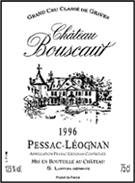
Classification: Classified growth (for reds and whites)
Owner: SA Château Bouscaut
Address: 33140 Cadaujac
Telephone: 05 57 83 12 20; Telefax: 05 57 83 12 21
Visits: By appointment only
Contact: Laurent Cogombles
VINEYARDS (RED)
Surface area: 123.5 acres
Grape varietals: 50% Merlot, 47% Cabernet Sauvignon, 3% Malbec
Average age of vines: 35 years
Density of plantation: 7,200 vines per hectare
Average yields: 48 hectoliters per hectare
Elevage: Twenty to thirty day fermentation in stainless-steel vats. Sixteen months aging in barrels with 50% new oak. Fining depending upon the vintage, filtration.
RED WINES PRODUCED
Château Bouscaut: 100,000 bottles
La Flamme de Bouscaut: 100,000 bottles
Plateau of maturity: Within 4–12 years of the vintage
Surface area: 14.8 acres
Grape varietals: 65% Semillon, 35% Sauvignon
Average age of vines: 30 years
Density of plantation: 7,200 vines per hectare
Average yields: 48 hectoliters per hectare
Elevage: Cold maceration for part of the yield. Fermentation and 11 months aging in barrels with 60% new oak. Fining depending upon the vintage, no filtration.
WHITE WINES PRODUCED
Château Bouscaut: 18,000 bottles
Lamothe Bouscaut: 18,000 bottles
Plateau of maturity: Within 2–6 years of the vintage
GENERAL APPRECIATION
Even though the 2001 and 2000 red Bouscaut (which are good as opposed to excellent) represent a marked improvement over their so-so predecessors, this consistent underperformer still has a long way to go if it wants to live up to its cru classé status. Despite reasonable prices, much better values are available from the Graves, especially among many of the well-run nonclassified growths like La Louvière or Rochemorin.
It was widely believed that after the American syndicate sold Bouscaut in 1979 to the well-known Bordeaux château owner Lucien Lurton, the quality at Bouscaut would improve. It has not. This property, among all of the classified growths of Graves, remains content to turn out unexciting white and red wines. The 18th-century château, with a lovely pool, was restored completely in the 1960s and is one of the most attractive in the region. Tasting the wines leaves the impression that there is a lack of a selection process. Some claim the high percentage of Merlot in the red wine (from young vines) has been detrimental to the wine’s quality. I do not agree with that; I simply think Bouscaut produces too much wine without a severe enough selection to put the best under the château’s name. Observers are hoping that the proprietor, Sophie Lurton (who was given the property by her father, Lucien Lurton, in 1992) will increase the level of quality. Both 2001 and 2000 represent a modest move in the right direction.
IMPORTANT VINTAGES (RED)
2001 |
This may be the finest Bouscaut I have ever tasted. It exhibits a deep ruby/purple color as well as an earthy, tobacco-scented nose, medium body, excellent richness and purity, and more texture as well as depth than I have seen in these wines for more than 20 years. Anticipated maturity: 2005–2015. |
2000 |
Finally, a reasonably good effort from this underachiever, Bouscaut’s 2000 possesses a dark ruby/purple color in addition to aromas of spicy new oak, red and black currant fruit. While superficial, there is more to it than most previous vintages have contained. Medium bodied, with sweet tannin, and a nicely textured, moderately endowed finish, it will drink well until 2015. Last tasted, 1/03. |
Sweet ripe currants, cherries, and berries intermixed with minerals, smoke, and new oak compete in this soft, straightforward, pleasant offering. Drink it over the next 8–10 years. Last tasted, 3/02. |
|
1998 |
Although the color is an attractive dark ruby, this light- to medium-bodied effort reveals considerable hollowness in the mid-palate. While some Pessac-Léognan aromas of scorched earth, red currant, and gravel emerge, there is little depth or length. Anticipated maturity: now–2012. Last tasted, 3/02. |
1990 |
Deep in color, with an appealing smoky, oaky, ripe berry–scented nose, the 1990 Bouscaut possesses less substance and aging potential than the 1989 or 1988. Last tasted, 1/93. |
1989 |
The 1989 Bouscaut is light, medium-bodied, and correct, but it has more alcohol, extremely high tannins that appear excessive for its straightforward, fruity personality, and a great deal of oak. If it fills out and develops a mid-palate (unlikely), this offering may merit a higher score. Anticipated maturity: now. Last tasted, 1/93. |
IMPORTANT VINTAGES (WHITE)
2001 |
This is a crisp, elegant white, offering notes of grapefruits and minerals. It is light to medium-bodied, with fine fruit, a moderate bouquet, and the potential for 10–12 years of longevity. Last tasted, 1/03. |
2000 |
Straightforward and correct, Bouscaut’s unexciting 2000 white wine reveals notions of minerals, mint, and citrus. Drink this light-bodied, monolithic offering over the next 7–8 years. Last tasted, 1/03. |
ANCIENT VINTAGES (RED)
In short, there is virtually nothing of interest from the 1980s and 1970s.
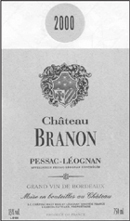
Classification: None
Owner: Sylviane Garcin-Cathiard
Address: 33850 Léognan
Mailing address: c/o Château Haut-Bergey, 33850 Léognan
Telephone: 05 56 64 05 22; Telefax: 05 56 64 06 98
E-mail: haut.bergey@wanadoo.fr
Visits: By appointment only
Contact: Hélène Garcin-Lévêque
VINEYARDS (RED)
Surface area: 3.7 acres (in production)
Grape varietals: 50% Cabernet Sauvignon, 50% Merlot
Average age of vines: 35 years
Density of plantation: 7,140 vines per hectare
Average yields: 30 hectoliters per hectare
Elevage: Fermentation in temperature-controlled wooden vats of small capacity (50 hectoliters) with indigenous yeasts. Malolactics and 18 months aging in new oak barrels. No fining, no filtration.
RED WINES PRODUCED
Château Branon: 6,000 bottles
No second wine is produced.
Plateau of maturity: Within 15 years of the vintage
GENERAL APPRECIATION
A luxury cuvée from Haut-Bergey, Branon is fashioned under the supervision of Bordeaux’s two most talented consultants, Jean-Luc Thunevin and Michel Rolland. It is a shocker in terms of its extraordinary richness as well as sense of place. Small quantities make it difficult to find, but the wine is worth a search of the marketplace. A must buy!
IMPORTANT VINTAGES
2001 |
The impressive, dense, purple-colored 2001 offers up notes of sweet tobacco, soil overtones, blueberry and blackberry liqueur, smoky, toasty oak, and a hint of espresso. A sweet, rich attack, sensational concentration, medium body, ripe tannin, and profound depth suggest a blockbuster 2000 rather than 2001. Anticipated maturity: 2006–2018. Last tasted, 1/03. |
2000 |
The debut vintage, 2000 is undoubtedly the real deal. Its opaque purple color is followed by strikingly sweet, smoky, black currant, cocoa, scorched earth, and graphite aromas. Full-bodied, remarkably concentrated, pure, and multitextured, with a finish that lasts nearly a minute, this fabulous wine will be fascinating to follow. Anticipated maturity: 2009–2025. Last tasted, 1/03. |
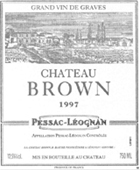
Classification: None
Owner: Bernard Barthe
Address: 33850 Léognan
Telephone: 05 56 87 08 10; Telefax: 05 56 87 87 34
E-mail: chateau.brown@wanadoo.fr
Website: www.chateau-brown.com
Visits: By appointment only
Contact: Odile Lepetit or Catherine Gabrile
VINEYARDS (RED)
Surface area: 57 acres
Grape varietals: 65% Cabernet Sauvignon, 32% Merlot, 3% Petit Verdot
Average age of vines: 15 years
Density of plantation: 7,400 vines per hectare
Average yields: 45 hectoliters per hectare
Elevage: Fermentation and 21–27 day maceration in temperature-controlled stainless-steel vats. Eighteen months aging in barrels, with 33% new oak. Fining, no filtration.
RED WINES PRODUCED
Château Brown: 80,000 bottles
Le Colombier de Château Brown: 30,000 bottles
Plateau of maturity: Within 3–12 years of the vintage
VINEYARDS (WHITE)
Surface area: 12 acres
Grape varietals: 67% Sauvignon Blanc, 33% Semillon
Average yields: 45 hectoliters per hectare
Elevage: Fermentation and 8–10 months aging in barrels that are renewed by half for each vintage. Fining, no filtration.
WHITE WINES PRODUCED
Château Brown: 20,000 bottles
Le Colombier de Château Brown: 20,000 bottles
Plateau of maturity: 2–7 years
GENERAL APPRECIATION
An underrated estate that has come on strongly in the 21st century, Château Brown is producing some of the finest wines I have ever tasted.
This estate, named after an 18th-century English wine merchant by the name of John Louis Brown, was acquired by the Barthe family in 1994. Considerable investments have been made in the well-placed vineyards (not far from Léognan) as well as the winery. The entire vineyard is planted on a gravel-based ridge with an excellent exposure. This is a property to watch.
IMPORTANT VINTAGES (RED)
2001 |
A strong effort from this underrated estate, this deep ruby–colored 2001 reveals big, sweet aromas of tobacco, cedar, fruitcake, and red currants. Medium bodied, with sweet tannin, excellent, possibly outstanding ripeness, and a long, pure, nicely textured finish, it will be at its finest between 2004 and 2012. Last tasted, 1/03. |
2000 |
Undoubtedly the most impressive wine I have ever tasted from Brown, the dense ruby/purple-colored 2000 offers up excellent aromas of cassis, red currants, cedar, and tobacco. Medium bodied, with super concentration as well as purity, power combined with elegance, and a moderately tannic finish. Anticipated maturity: 2005–2015. A sleeper of the vintage. |
1999 |
A medium-weight Graves, this savory, perfumed 1999 offers spicy, earthy tobacco, and sweet cherry/currant fruit in a medium-bodied, soft style. Enjoy it over the next 3–4 years. Last tasted, 3/02. |
1998 |
Soft, scorched-earth, currant, cherry, and graphite-like flavors characterize this spicy, sweet, medium-bodied, elegant, supple offering. A delicious, textbook Graves made in a medium-weight style, it will drink well for 3–4 years. Last tasted, 3/02. |
2001 |
Citrus, fig, green bean, and smoky scents jump from the glass of this medium-bodied, nicely textured, ripe, concentrated dry white Graves made from 67% Sauvignon Blanc and 33% Semillon. It should drink well for 7–8 years. Last tasted, 1/03. |
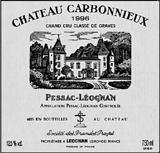
Classification: Classified growth (reds and whites)
Owner: Société Civile des Grandes Graves—Perrin family
Address: 33850 Léognan
Telephone: 05 57 96 56 20; Telefax: 05 56 96 59 19
E-mail: chateau-carbonnieux@wanadoo.fr
Website: www.carbonnieux.com
Visits: By appointment Monday to Friday, 8:30–11 A.M. and 2–5 P.M.
Contact: Béatrice Arnaud
VINEYARDS (RED)
Surface area: 111.2 acres
Grape varietals: 60% Cabernet Sauvignon, 30% Merlot, 7% Cabernet Franc, 2% Malbec, 1% Petit Verdot
Average age of vines: 40 years
Density of plantation: 7,200 vines per hectare
Average yields: 50 hectoliters per hectare
Elevage: Fermentation and 21 day maceration in temperature-controlled stainless-steel vats.
Eighteen months aging in barrels that are renewed by a third at each vintage. Fining and filtration.
RED WINES PRODUCED
Château Carbonnieux: 200,000 bottles
Château Tour Léognan: 40,000 bottles
Plateau of maturity: Within 7–10 years of the vintage
VINEYARDS (WHITE)
Surface area: 103.7 acres
Grape varietals: 60% Sauvignon Blanc, 38% Semillon, 2% Muscadelle
Average age of vines: 40 years
Density of plantation: 7,200 vines per hectare
Average yields: 50 hectoliters per hectare
Elevage: Fermentation and 10 months aging on lees in barrels that are renewed by a third at each vintage. Fining and filtration.
WHITE WINES PRODUCED
Château Carbonnieux: 200,000 bottles
Château Tour Léognan: 40,000 bottles
Plateau of maturity: Within 3–20 or more years of the vintage
GENERAL APPRECIATION
Very Burgundian, with a Volnay-like personality, the red Carbonnieux has much improved since 1985 and now lives up to its status. It can sometimes be perceived as somewhat light, but this is the mode of expression of this supple and tasty wine, which is graceful and elegant in a low-key manner. Consumers looking for potentially long-lived efforts should stay clear of it, but lovers of fruity and quintessentially elegant Graves will be satisfied in most vintages. Prices remain reasonable. As for the white wines, they have always been excellent, and in some vintages very long-lived.
Carbonnieux, one of the largest estates of Graves, had, until the mid-1980s, fit into the pattern of many of the winemaking estates of the Pessac-Léognan area—the white wines were frequently delicious, but the red wines innocuously light and bland. Since the mid-1980s that has changed for the better, with the white wine taking on even higher-quality aspirations and the red wine becoming tasty, elegant, supple, and well made.
The property is not only of historic significance, but is among the most scenic of the region. The history of the vineyards can be traced to the 13th century, but the modern era of Carbonnieux began in 1956 when Marc Perrin acquired the estate. His son, Anthony, now oversees the winemaking. In the mid-1980s Anthony Perrin hired the famed Denis Dubourdieu, to give the whites even more fragrance and concentration. Additionally, the reds have taken on greater depth and intensity.
Most vintages of Carbonnieux, both the red and white wines, should be drunk in their first 7–10 years. Some of the white wine vintages have a remarkable potential to last for up to two or three decades.
IMPORTANT VINTAGES (RED)
2001 |
An elegant, graceful effort (much like the proprietor), this deep ruby–colored 2001 reveals aromas of sweet black cherries intermixed with loamy soil scents. Medium-bodied, with supple tannin as well as a long, flowing finish, it is a classic effort of restraint and measured richness that should drink well young yet age nicely for 10–15 years. Last tasted, 1/03. |
2000 |
Probably the finest Carbonnieux I have tasted in more than three decades, this deep ruby/purple–colored offering reveals complex aromas of black cherries, currants, tobacco, soy, and earth. Medium bodied with gorgeous purity, more glycerin and depth than usual, and subtle toasty oak in the background, this is a beautiful example of refinement and breeding. Anticipated maturity: 2006–2018. Last tasted, 1/03. |
1999 |
This light-bodied, soft, round, picnic-styled claret reveals jammy cherry fruit mixed with herb-tinged tobacco notes. It is best consumed over the next 5–6 years. Last tasted, 3/02. |
Very Burgundian-like in its vivid black cherry/smoky nose, this medium-bodied, somewhat light but racy, tasty wine is graceful in a low-keyed manner. It will not make old bones, but it is well knit and charming. Enjoy it over the next 7–8 years. Last tasted, 3/02. |
|
1997 |
This is a light-bodied, picnic-styled claret with evidence of dilution as well as soft cherry/raspberry fruit flavors reminiscent of a lighter-styled Burgundy. Drink it over the next 2–3 years. Last tasted, 1/02. |
1996 |
This is a stylish, medium-bodied, dark ruby–colored wine with attractive cherry and raspberry fruit intermixed with toasty notes in both the aromatics and flavors. This elegant wine reveals a Volnay-like personality. It should drink well until 2008. Last tasted, 1/02. |
1995 |
An attractive, sexy effort from Carbonnieux, this medium-bodied, deep ruby–colored wine reveals subtle aromas of smoky oak intertwined with tobacco, kirsch, and black currant fruit. In the mouth, elegance, balance, suppleness, finesse, and an overall allure characterize this round, lightly tannic, lush, and captivating claret. Anticipated maturity: now–2011. Last tasted, 3/01. |
1994 |
Carbonnieux’s 1994 displays a medium dark ruby color, a sweet, ripe nose of currants and cherries, spicy new oak, austere, lean flavors, and high tannin. There is a lack of complexity, fruit, and flesh in this dry, hard, woody wine. Anticipated maturity: now. Last tasted, 1/97. |
IMPORTANT VINTAGES (WHITE)
2001 |
A gorgeous Carbonnieux, this is the finest dry white I have tasted in many years. A light straw color accompanies enticing aromas of figs, lemon zest, grapefruit, and honeysuckle. Medium bodied with good acidity, loads of fruit and depth, and a long, concentrated finish, it should evolve beautifully for 15+ years. Last tasted, 1/03. |
2000 |
Although monolithic, this is a competent effort displaying notes of lemon zest and honey. Medium bodied with admirable fruit, but neither the depth nor complexity of the 2001, it should drink well for 10–12 years. Last tasted, 1/03. |
ANCIENT VINTAGES (RED)
Most of the top vintages of the 1980s and 1990s were competent efforts, meriting scores between 85 and 87 points. Some of the great old vintages (1961, 91 points; last tasted 3/99; and 1959, 89 points; last tasted 1/03) remain brilliant wines. I hope recent vintages are capable of achieving this level of quality.
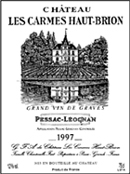
Classification: None
Owner: Furt/Chantecaille families
Administrator: Didier Furt
Address: 197, avenue Jean Cordier, 33600 Pessac
Telephone: 05 56 51 49 43; Telefax: 05 56 93 10 71
E-mail: chateau@les-carmes-haut-brion.com
Website: www.les-carmes-haut-brion.com
Visits: By appointment only
Contact: Didier Furt
Surface area: 11.4 acres
Grape varietals: 50% Merlot, 40% Cabernet Franc, 10% Cabernet Sauvignon
Average age of vines: 35–40 years
Density of plantation: 10,000 vines per hectare
Average yields: 46 hectoliters per hectare
Elevage: Fifteen to twenty-one day fermentation and maceration in temperature-controlled stainless-steel vats. Malolactics and 18 months aging in barrels with 50% new oak. Fining and filtration depending upon the vintage.
RED WINES PRODUCED
Château Les Carmes Haut-Brion: 22,000 bottles
Le Clos des Carmes: 4,000 bottles
Plateau of maturity: Within 6–15 years of the vintage
GENERAL APPRECIATION
This tiny gem of an estate offers superb wines that are difficult to find because of the minuscule production. Recent vintages have consistently qualified as sleepers. In top vintages, the wines possess nearly as much complexity as the great Haut-Brion, but not the density of that renowned terroir. They owe their extraordinary finesse as well as explosive aromatics to their relatively high percentage of Cabernet Franc. This underrated effort undoubtedly merits more attention from shrewd consumers as it remains reasonably priced. It would also deserve upgrading to cru classé status.
In the early 1970s I had the good fortune to walk into a wine shop that was discounting magnums of the 1959 Les Carmes Haut-Brion. I knew nothing about the wine, but I took a chance and bought two magnums. Both proved to be spectacular, and every effort I made to find the wine thereafter was futile. Little did I know then that this tiny jewel of a vineyard, situated on a gravelly knoll in the Bordeaux suburb of Pessac, near the famed Haut-Brion and La Mission Haut-Brion, is the most obscure and least known top-quality red wine of Pessac-Léognan. A visit is highly recommended as this estate has the look of a medieval fairy-tale castle surrounded by beautiful grounds.
The vineyard is named for the group of friars, called Les Carmes, who owned this vineyard between 1584 and 1789. During the French Revolution, the religious order was divested of ownership.
Les Carmes Haut-Brion is a rich, full wine, no doubt because the Merlot vines benefit from the gravelly and clayey soil in which they are planted. A traditional approach to winemaking results in wines that are classic expressions of Graves, deeply colored, intense, and complex. Unfortunately, most of the wine from Les Carmes Haut-Brion is sold by Monsieur Chantecaille through his négociant business in Bordeaux to European markets. Since so little wine is made, the chances of finding any in America are remote.
This is a wine that comes closest to expressing the quality of Haut-Brion and La Mission Haut-Brion, not surprisingly, as the vineyards and terroir are essentially the same. This small, consistently top-notch performer in Pessac is worth searching out.
2001 |
Modeled along the lines of the 1999, but even more elegant, this dark ruby/purple–colored 2001 reveals aromas of sweet berry fruit, spice box, and smoke. It is light to medium bodied, soft, tasty, and potentially complex and nuanced. While it does not possess the size, volume, or aging potential of the 2000 or 1999, the 2001 is a beautifully made wine. Anticipated maturity: 2005–2012. Last tasted, 1/03. |
2000 |
A quintessential model of both Graves and the elegance of high-class Bordeaux, the 2000 is probably the finest Les Carmes I have ever tasted. It ratchets up the level of concentration, opulence, and sumptuousness. Medium to full-bodied, layered, and lush, with extraordinary aromatic complexity (cigar tobacco, earth, coffee, black currants, and ripe plums/prunes), stunning purity, a seamless texture, and sweet tannin, it will provide thrilling drinking between 2005 and 2020. At present, it is tight and closed, but aeration brings out its perfume. A big-time sleeper of the vintage. Last tasted, 1/03. |
1999 |
An elegant, soft, tobacco-infused, red currant and cherry-flavored effort, this dark ruby/purple–colored 1999 is sweet and expansive on the attack, sexy, complex, earthy, and long. Consume this medium-weight Graves during its first 6–10 years of life. It is an impressive 1999. Last tasted, 3/02. |
1998 |
A stunning wine, as well as one of the sleepers of the vintage, this dense purple–colored 1998 offers up classic Graves aromas of tar, roasted meats, scorched earth, black currants, and barbecue spices. It is beautifully elegant, yet rich, concentrated, and deep, with medium to full body, laudable sweetness on the entry, and ripe tannin in the finish. A bottle kept open for 24 hours was significantly better than it was upon opening, suggesting this wine will have terrific longevity. Haut-Brion enthusiasts are advised to check out this beautifully made offering. Anticipated maturity: 2004–2020. Last tasted, 3/02. |
1997 |
Hippie-incense-like smells jump from the glass of this complex, herb, tobacco, smoky, peppery, fragrant wine. Medium ruby–colored, with light to medium body, it is full of finesse, fruit, charm, and suppleness. This is a sexy offering to enjoy over the next 2–3 years. While there is neither great depth nor length, this example of Les Carmes Haut-Brion is beautifully complex and supple. Last tasted, 1/02. |
1996 |
A medium ruby–colored, sexy, seductive Graves, with loads of tobacco-tinged, jammy cherry fruit intermixed with smoke and earth, this spicy, round, generous 1996 reveals no hard edges. It continues to be one of the most stylish, underrated wines from the Pessac-Léognan region. Although it will not be long-lived, this wine offers plenty of appeal for drinking over the next 5–6 years. Last tasted, 3/01. |
1995 |
A classic example of Graves’s smoky, tobacco-tinged, berry fruit, this is a medium-bodied, sweet, round, berry, complex, elegant, savory 1995 with no hard edges. Low acidity and a luscious, ripe Merlot component dominate the wine, giving it immediate appeal. This is a plump, delicious wine. Anticipated maturity: now–2006. Last tasted, 12/00. |
ANCIENT VINTAGES (RED)
Nearly all the top vintages merit scores of 86–88, although occasionally this property hits the high points (the 1959, 92 points, last tasted 12/85; and 1945, 93 points, last tasted 12/95).
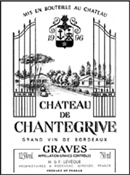
Classification: None
Owner: Françoise and Henri Lévêque
Address: 33720 Podensac
Telephone: 05 56 27 17 38; Telefax: 05 56 27 29 42
E-mail: courrier@chateau-chantegrive.com
Website: www.chantegrive.com
Visits: Monday to Saturday 9 A.M.–noon and 2–5 P.M.
Contact: Hélène Lévêque
VINEYARDS (RED)
Surface area: 140.8 acres
Grape varietals: 50% Cabernet Sauvignon, 50% Merlot
Average age of vines: 25 years
Density of plantation: 6,600 vines per hectare
Average yields: 42 hectoliters per hectare
Elevage: Fermentation and maceration in temperature-controlled stainless-steel tanks of 100 hectoliter capacity with frequent pumpings-over. Malolactics and 14 months aging in barrels that are renewed by a third at each vintage. Fining, no filtration.
RED WINES PRODUCED
Château de Chantegrive: 150,000 bottles
Benjamin de Chantegrive: 120,000 bottles
Plateau of maturity: Within 3–10 years of the vintage
VINEYARDS (WHITE)
Surface area: 86.5 acres
Grape varietals: 50% Sauvignon Blanc, 50% Semillon
Average age of vines: 34 years
Density of plantation: 6,600 vines per hectare
Average yields: 35 hectoliters per hectare
Elevage: Generic—Fermentation and nine months aging in stainless-steel vats. No fining, filtration upon bottling. Cuvée Caroline—Skin maceration, fermentation, and nine months aging on lees in barrels (50% new oak) with weekly stirrings. No fining, light filtration upon bottling.
WHITE WINES PRODUCED
Château de Chantegrive: 70,000 bottles
Château de Chantegrive Cuvée Caroline: 65,000 bottles
Plateau of maturity: Within 2–4 years of the vintage (best vintages of Cuvée Caroline may hold 6–7 years)
While rarely profound, the red Chantegrive is soundly made and represents a good value because of its reasonable price. In terms of quality, this wine is equivalent to a good Médoc Cru Bourgeois. The whites are excellent, especially the best vintages of Cuvée Caroline, which can rival the classified growths of Pessac-Léognan.
When I am eating in a Bordeaux restaurant, the red and white wines I often search out for value and quality are those made at the attractive Château de Chantegrive, located just north of the village of Podensac, adjacent to Route Nationale 113. While proprietor Henri Lévêque can trace his family’s wine heritage back to 1753, he alone resurrected this property from obscure standing in 1962 to one that is now recognized for high-quality red and white wines that represent excellent quality/price rapport.
This is one cellar where everything from barrel cellar to fermentation rooms are temperature and humidity controlled. In the mid-1980s a luxury cuvée of Lévêque’s white Graves, the Chantegrive Cuvée Caroline, was introduced. It is as good as some of the more renowned crus classés. Neither the white nor the red wine is meant to be long-lived, but rather to be drunk in the first 5–7 years of life. A strong argument can even be made for drinking the white wines before they reach the age of 5. Nevertheless, the wines are consistently well made, even in lighter-weight vintages, and are textbook examples of their appellation.
Frugal consumers looking for wines that satisfy both the palate and the purse should seek out this consistent overachiever in the southern Graves region.
IMPORTANT VINTAGES (RED)
2000 |
The excellent 2000 displays aromas of scorched earth, ripe black cherry and currant fruit, tobacco, and cigar smoke. Ripe, medium bodied, soft, and attractive, it will be drinkable young and until 2012. Last tasted, 1/03. |
IMPORTANT VINTAGES (WHITE)
2001 |
Cuvée Caroline: A top-notch effort, the 2001 Cuvée Caroline exhibits well-integrated toasty notes intermixed with scents of honeysuckle, orange marmalade, smoky nuts, and citrus. Medium bodied, with delicious fruit as well as good underlying acidity, this beauty will drink well over the next 3–4 years. It is a fine value. |
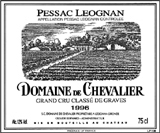
Classification: Classified growth (reds and whites)
Owner: Bernard family
Administrator: Olivier Bernard
Address: 102, chemin de Mignoy, 33850 Léognan
Telephone: 05 56 64 16 16; Telefax: 05 56 64 18 18
E-mail: domainedechevalier@domainedechevalier.com
Website: www.domainedechevalier.com
Visits: By appointment Monday to Friday 9 A.M.–noon and 2–5 P.M.
Contact: Oliver Bernard or Rémy Edange
VINEYARDS (RED)
Surface area: 74.1 acres
Grape varietals: 65% Cabernet Sauvignon, 30% Merlot, 2.5% Cabernet Franc, 2.5% Petit Verdot
Average age of vines: 30 years
Density of plantation: 10,000 vines per hectare
Average yields: 45–48 hectoliters per hectare
Elevage: Fermentation at temperatures below 30°C and three-week maceration in temperature-controlled stainless-steel and epoxy-lined vats of 100-and 150-hectoliter capacity. Eighteen to twenty-two months aging in barrels that are renewed by a third at each vintage. Fining and filtration.
RED WINES PRODUCED
Domaine de Chevalier: 80,000 bottles
L’Esprit de Chevalier: 90,000 bottles
Pessac-Léognan: 25,000 bottles
Plateau of maturity: Within 5–15 years of the vintage
VINEYARDS (WHITE)
Surface area: 11.1 acres
Grape varietals: 70% Sauvignon Blanc, 30% Semillon
Average age of vines: 30 years
Density of plantation: 10,000 vines per hectare
Average yields: 40 hectoliters per hectare
Elevage: Fermentation and 18 months aging on lees in barrels with 30% new oak. Fining and filtration.
WHITE WINES PRODUCED
Domaine de Chevalier: 12,000 bottles
L’Esprit de Chevalier: 10,000 bottles
Plateau of maturity: Within 10–35 years of the vintage
GENERAL APPRECIATION
As far as the reds are concerned, Domaine de Chevalier was a notorious underperformer during the early 1990s. Since then, the red wines have improved dramatically. The whites have always been top-notch, but the minuscule production makes them difficult to find. Domaine de Chevalier is expensive.
The tiny estate of Domaine de Chevalier, tucked away in the midst of a forest on the southwest outskirts of Léognan, is a true connoisseur’s wine. The production is tiny and the wines are among the most highly sought of Pessac-Léognan, but most important, the quality can be impeccably high.
Domaine de Chevalier’s fame was no doubt due to the aristocratic Claude Ricard, who inherited the property in 1942 but because of family squabbles had to sell the estate in 1983 to the large Bernard distilling company. Claude Ricard was retained to run the property but finally turned over the reins of Domaine de Chevalier to Olivier Bernard.
The red wines of Domaine de Chevalier do not resemble the intense, rich, earthy style of Graves, best exemplified by Haut-Brion and La Mission Haut-Brion. Until the 1990s, the Domaine de Chevalier wines possessed a subtle, mineral, earthy aspect but were much lighter in body and tended to be more Médoc-like in style than the Graves wines from Pessac and Talence. Since the new owners acquired the property, there has been an intentional effort to produce a bigger, more structured, and powerful wine. There are no problems with that, but excessive oakiness in the early 1990s often obliterated the wine’s charm and finesse, the telltale personality traits of Domaine de Chevalier.
The white Domaine de Chevalier is the only wine I know of in the Bordeaux region that spends over a year and a half in new oak casks. The production is tiny, and the wine, while fabulous when drunk from cask, usually closes up after bottling, not to blossom for 10 or more years. Yet it has the distinction of actually taking longer to mature, and aging even more gracefully, than the superb red wine. It can easily last 25–35 years, clearly outliving the red wine in most vintages.
Anyone who visits the southern portion of Pessac-Léognan (the northern sector of Graves) will have a difficult time finding Domaine de Chevalier. I became impossibly lost on my first trip to the property in the late 1970s. The cream-colored château, surrounded on three sides by a pine forest, can be found by taking D109 east from Léognan in the direction of Cestas. Signs indicating the entrance to the vineyard of Domaine de Chevalier will guide the traveler to the château.
The soil of this relatively small vineyard has a gravel bed but also contains clay, iron, and considerable black sand. Two problems encountered here are that spring frosts and frequent hail can severely damage the crop. Inexplicably, no other major châteaux of the Bordeaux region suffer these two natural calamities as frequently as Domaine de Chevalier.
Domaine de Chevalier is an expensive wine, fetching prices similar to those of a Médoc second growth.
IMPORTANT VINTAGES (RED)
ANCIENT VINTAGES (RED)
The glorious 1978 (93 points; last tasted 1/03) is one of the vintage’s superstars. Fully mature, and unlikely to get any better, owners should not push their luck. The 1970 (90 points; last tasted 6/96) has always been one of my favorites, but I suspect it is now beginning to decline. Other top-flight vintages have been the 1964 (90 points; last tasted 11/89), 1959 (89 points; last tasted 3/88), and 1953 (92 points; last tasted 1/89). These have been among the most sensational Domaine de Chevaliers in my experience. None of them are blockbuster, powerful, massive efforts, but rather wines of extraordinary finesse, aromatic complexity, and balance.
IMPORTANT VINTAGES (WHITE)
2001 |
One of the great white Domaine de Chevaliers, the loaded 2001 tastes like liquid stones intermixed with honeyed grapefruit, orange marmalade, and smoked herbs. It boasts great intensity, a surprising amount of glycerin, and tremendous depth as well as persistence on the palate. It will undoubtedly close down and go into a backward stage, but it looks to be a legendary Domaine de Chevalier. Anticipated maturity: 2010–2040. Last tasted, 1/03. |
2000 |
One of the best dry whites of the vintage, the 2000 offers up notes of lanolin, citrus, grapefruit, smoke, and minerals with notions of toasty wood in the background. This medium-to full-bodied, deep, concentrated, pure, intense effort is a success for the vintage. It should hit its peak in 5–6 years and last for two decades. Last tasted, 1/03. |
1999 |
A zesty, herb-tinged, mineral-styled effort, the light straw–colored 1999 exhibits closed flavors, good acidity, but little depth and follow-through on the palate. Bottled Domaine de Chevaliers are tricky to taste, but the 1999 does not appear to have enough depth or intensity, particularly when compared to the 2001 and 2000. Anticipated maturity: 2005–2015. Last tasted, 3/02. |
1998 |
Tightly knit, with hints of green beans, melons, figs, and minerals, the 1998 is showing better from bottle than it did early in life. Medium bodied with the fig, melon, bell pepper, and grapefruit notes abundantly displayed in the flavors, it reveals a surprisingly long, refreshing finish. Anticipated maturity: 2007–2020. Last tasted, 3/02. |
1995 |
This is a solidly made, tightly knit, high-strung dry white wine with plenty of sulphur, wood, and acidity. The wine is slowly fleshing out, so it may ultimately deserve a higher rating, but the shrill levels of tart acid and pronounced oakiness give cause for concern. Nevertheless, it is a medium-bodied, reasonably well-made dry white Graves that should age effortlessly for two decades. Anticipated maturity: 2005–2015. Last tasted, 3/97. |
This could turn out to be the finest Domaine de Chevalier since the 1983 and 1985. Displaying less oak than normal, the big, honeyed, cherry, smoky, and melon scents in the nose are followed by a full-bodied, powerful, dense, highly concentrated wine that lingers on the palate for nearly 45 seconds. This should be one of the bigger, more concentrated and powerful Domaine de Chevaliers made in the last 20 years. Given the performance of past top vintages, expect this wine to close up for 10–15 years after bottling. It will age well for 25–30+ years. Last tasted, 3/97. |
|
1990 |
Although somewhat monolithic, the 1990 Domaine de Chevalier blanc is still a relatively young dry white. It displays a hint of lemon zest, orange blossom, figs, and melons. Medium bodied and austere, but reasonably long in the finish, it is hard to know in what direction it will go as it does not appear to possess the delineation of the great vintages. Anticipated maturity: now–2012. Last tasted, 6/02. |
1989 |
An intense oakiness remains noticeable in this 1989, which has never been as exciting as the estate’s reputation would indicate. Notes of wet stones, cold steel, Provençal herbs, and underripe peach and melon characteristics are still dominated by wood. This medium-bodied effort is a bit short in the finish. Anticipated maturity: now–2010. Last tasted, 6/02. |
1988 |
A great white from Domaine de Chevalier, the 1988 offers up sumptuous aromas of honeysuckle, minerals, white flowers, figs, and smoky wood. Rich and medium to full-bodied, with tremendous persistence on the palate, this youthful offering should have a tremendous upside over the next two decades. Anticipated maturity: now–2020. Last tasted, 6/02. |
1987 |
1987 is a terribly underrated vintage for white Graves. This wine has more depth, ripeness, and complexity than either the 1989 or 1986, the two vintages that most casual observers would think to be superior. Pale straw in color with a more evolved, honeyed, herb-, mineral-, and orange-scented bouquet, this medium-bodied, surprisingly soft, forward Domaine de Chevalier has excellent depth, moderate acidity, and an oaky, alcoholic finish. Anticipated maturity: now. Last tasted, 11/90. |
1986 |
Pale straw in color, with a decidedly oaky, ungenerous bouquet, the 1986 is steely, tightly knit, extremely austere, and difficult to appreciate or assess. If it develops more concentration and charm, it could merit a higher score, but my notes have been consistent since I first tasted it from barrel. Anticipated maturity: now. Last tasted, 3/90. |
1985 |
Another terrific vintage for Domaine de Chevalier, this sumptuous, dry white retains a light straw color with a hint of green as well as a stunning, herbaceous bouquet of passion fruit, figs, honeyed grapefruit, and spice box. A wine of great delineation, purity, and depth, it is just hitting its apogee. Anticipated maturity: now–2015. Last tasted, 6/02. |
1983 |
One of the all-time great Domaine de Chevalier blancs, the 1983 still looks like a 4–5-year-old wine. Its light to medium straw color is followed by glorious aromas of lanolin, marmalade, figs, minerals, and smoke. This intense, full-bodied, mouth-filling wine is gorgeously fresh yet explosively rich and persistent. It can be drunk now but promises to evolve for another 20 years. Last tasted, 6/02. |
ANCIENT VINTAGES (WHITE)
Few Bordeaux producers of dry white wines have such an impeccable track record as Domaine de Chevalier. The fabulous 1971 (93 points; last tasted 8/00) remains extraordinarily young and vivacious. The 1970 (93 points; last tasted 12/90) undoubtedly is still going strong, as is the renowned 1962 (93 points; last tasted 3/87). The top vintages of this estate’s white wines are almost immortal in terms of ageability. To reiterate, they consistently outlast the red wines by one to two decades.
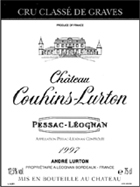
Classification: Classified growth (for whites only)
Owner: André Lurton
Address: 33850 Villenave d’Ornon
Mailing address: Vignobles André Lurton, Château Bonnet, 33420 Grézillac
Telephone: 05 57 25 58 58; Telefax: 05 57 74 98 59
E-mail: andrelurton@andrelurton.com
Website: www.andrelurton.com
No visits
VINEYARDS (WHITE)
Surface area: 14.8 acres
Grape varietals: 100% Sauvignon Blanc
Average age of vines: 15–18 years
Density of plantation: 6,500 vines per hectare
Average yields: 45 hectoliters per hectare
Elevage: After cold settling, 10 to 15 day fermentation (at 18–23°C) in barrels with 30–50% new oak. One year aging on lees with regular stirrings. Fining and filtration.
WHITE WINES PRODUCED
Château Couhins-Lurton: 20,000 bottles
Plateau of maturity: Within 3–15 years of the vintage
GENERAL APPRECIATION
Couhins-Lurton easily merits its cru classé status. It is also a fine value.
André Lurton, another member of the ubiquitous Lurton family, enthusiastically runs this small gem of a property. Made from 100% Sauvignon Blanc, fermented in new oak, and aged for nearly 10 months prior to bottling, this is a consistently superb white Graves of surprising complexity, richness, and length. I would not age it past 10–15 years, but that reflects my personal predilection for drinking these wines relatively young and fresh. The price of Couhins-Lurton has not yet caught up to the quality, and enthusiasts of white Graves should be seeking out this difficult to find but impeccably made wine.
2001 |
A beautiful, pure Sauvignon, the 2001 offers opulent notes of grapefruit, honey-suckle, melons, and figs. It is a light- to medium-bodied, well-delineated, crisp offering with a long finish. Anticipated maturity: now–2015. Last tasted, 1/03. |
1998 |
A powerful Couhins, the 1998 exhibits abundant quantities of herbs and smoke in the background. With tart acidity as well as a creamy texture, it is well worth searching out. Anticipated maturity: now–2012. Last tasted, 1/03. |
ANCIENT VINTAGES
My experience with Couhins suggests it should be drunk relatively young, but my tasting notes for 1993 (90 points) and 1990 (91 points) were filled with enthusiasm when last tasted in spring 2000.
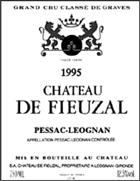
Classification: Classified growth (for reds only)
Owner: Lochlann Quinn
Address: 124, avenue de Mont-de-Marsan, 33850 Léognan
Telephone: 05 56 64 77 86; Telefax: 05 56 64 18 88
E-mail: ch.fieuzal@terre-net.fr
Website: www.fieuzal.com
Visits: By appointment only
Contact: Brigitte Talon
VINEYARDS (RED)
Surface area: 93.9 acres
Grape varietals: 60% Cabernet Sauvignon, 30% Merlot, 8% Cabernet Franc, 2% Petit Verdot
Average age of vines: 30 years
Density of plantation: 9,091 vines per hectare
Average yields: 40 hectoliters per hectare
Elevage: Cold maceration. Fermentation (at 27°C) in temperature-controlled vats. Malolactics and 18–24 months aging in barrels that are renewed by a third every vintage. Fining, no filtration.
RED WINES PRODUCED
Château de Fieuzal: 100,000 bottles
L’Abeille de Fieuzal: 60,000 bottles
Plateau of maturity: Within 5–25 years of the vintage
VINEYARDS (WHITE)
Surface area: 24.7 acres
Grape varietals: 50% Sauvignon Blanc, 50% Semillon
Average age of vines: 30 years
Density of plantation: 9,091 vines per hectare
Average yields: 40 hectoliters per hectare
Elevage: Direct pressing. Fermentation and 16–18 months aging on lees in barrels (50% new oak for Semillon and one-year-old barrels for Sauvignon Blanc). Fining, no filtration.
WHITE WINES PRODUCED
Château de Fieuzal: 40,000 bottles
L’Abeille de Fieuzal: 40,000 bottles
Plateau of maturity: Within 4–10 years of the vintage
GENERAL APPRECIATION
While they have always been good, the wines of this estate have improved considerably since the mid-1980s. In the best vintages, both the reds and whites can compete with the stars of the appellation. Despite their consistently high quality, the wines of de Fieuzal do not seem to enjoy the popularity of some of their peers (for example, Pape Clément). Because it is still underrated, de Fieuzal represents a very good buy, especially in the great vintages.
De Fieuzal has always been one of the more obscure Graves, which is surprising given the fact that it is a relatively old property and is well recognized by the inhabitants of the region. The cellars are located in the rolling countryside adjacent to D651 on the outskirts of Léognan in the direction of Saucats. De Fieuzal’s obscurity appears to have ended abruptly during the mid-1980s, when the wines became noticeably richer and more complex. This is not to say that older vintages were not well made. Many of them were, but they certainly did not have the dazzling character that more recent years have possessed.
Much of the credit for de Fieuzal’s rise in quality must go to the enthusiastic administrator, Gérard Gribelin, who took over the running of the property in 1974. In 1977 stainless-steel, temperature-controlled fermentation tanks were installed, and there has been an increasing tendency since the 1980s to prolong the maceration period and use more new oak. The breakthrough for the white wine of de Fieuzal came in 1985, when the property made the first of what was to be a series of stunning white Graves. Gribelin recognizes that his now retired technical director and winemaker, Monsieur DuPouy, contributed greatly to the restoration of de Fieuzal’s reputation. DuPouy was, by any standard of measurement, a perfectionist and displayed remarkable talent and flexibility in supervising the winemaking at de Fieuzal. Amazingly, the high quality has not been accompanied by soaring prices, as de Fieuzal represents one of the best quality/price ratios in the entire Graves region.
IMPORTANT VINTAGES (RED)
ANCIENT VINTAGES (RED)
I have good notes for the 1986 (87 points; last tasted 1/97), 1985 (87 points; last tasted 1/97), and 1970 (87 points; last tasted 1/97). However, vintages since the mid- to late-1990s are far superior to what was produced in the past.
IMPORTANT VINTAGES (WHITE)
2001 |
A tremendous effort from de Fieuzal, this exceptionally rich, dry white offers up aromas of honeysuckle, orange marmalade, roasted herbs, figs, and melons. Medium to full-bodied, exceptionally concentrated, with great definition and zestiness, this impressive effort should have 20–25 years of longevity. Anticipated maturity: 2007–2020. Last tasted, 1/03. |
2000 |
This is a competent albeit monolithic, straightforward, foursquare effort without the nuances one expects. It exhibits plenty of oak, some melony fruit, but a short finish. Anticipated maturity: now–2010. Last tasted, 1/03. |
ANCIENT VINTAGES (WHITE)
De Fieuzal produced an excellent 1996 (88 points; last tasted 1/03), 1995 (88 points; last tasted 3/97), and a brilliant 1994 (92 points; last tasted 3/97). Top efforts were produced in years such as 1993 and 1992, both of which were rated 90 when last tasted in 1/03. While I have not had them recently, the 1988 (92 points; last tasted 1/96) and 1985 (93 points; last tasted 7/97) were turnaround vintages for de Fieuzal’s white wine program. It is unquestionably one of the top half-dozen dry white wines of Bordeaux, and it is worth a special effort to find and purchase.
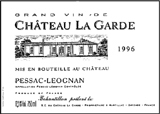
Classification: None
Owner: Dourthe Frères
Address: 1, chemin de la Tour, 33650 Martillac
Mailing address: 35, rue de Bordeaux, 33290 Parempuyre
Telephone: 05 56 35 53 00; Telefax: 05 56 35 53 29
E-mail: contact@cvbg.com
Visits: By appointment only
Contact: Marie-Hélène Inquimbert
VINEYARDS (RED)
Surface area: 124.9 acres
Grape varietals: 52% Cabernet Sauvignon, 48% Merlot
Average age of vines: 23 years
Density of plantation: 6,250 vines per hectare
Average yields: 42–43 hectoliters per hectare
Elevage: Cold maceration. Fermentation and maceration in temperature-controlled stainless-steel and wooden vats with pigeage. Part of yield undergoes malolactics in barrel. Twelve to eighteen months aging with 40–60% new oak.
RED WINES PRODUCED
Château La Garde: 160,000 bottles
La Terrasse de La Garde: 100,000 bottles
Plateau of maturity: Within 2–6 years of the vintage
VINEYARDS (WHITE)
Surface area: 4.5 acres
Grape varietals: 100% Sauvignon
Average age of vines: 10 years
Density of plantation: 6,000 vines per hectare
Average yields: 42–43 hectoliters per hectare
Elevage: Skin maceration. Fermentation and 12 months aging on fine lees in new oak barrels.
WHITE WINES PRODUCED
Château La Garde: 12,000 bottles
No second wine is produced.
Plateau of maturity: Within 2–4 years of the vintage
GENERAL APPRECIATION
This is a reliable estate, particularly since the large négociant Dourthe became the proprietor in 1990.
An impressive-looking estate sitting on gravel outcroppings south of the village of Martillac, this ancient property appears set to make an important rebound.
IMPORTANT VINTAGES (RED)
2001 |
An excellent, textbook Graves, this 2001 reveals sweet red currant, cherry, smoked herb, and earth aromas. Its opaque ruby/purple color is accompanied by firm tannin, medium body, and excellent ripeness as well as depth. Anticipated maturity: 2006–2013. Last tasted, 1/03. |
2000 |
Elegant, smoky, roasted herb, tobacco, and sweet red and black currant aromas jump from the glass of this opaque ruby/purple–colored offering. Medium bodied and lush, with copious sweetness, low acidity, and ripe tannin, this is a sleeper of the vintage. Anticipated maturity: 2006–2017. Last tasted, 1/03. |
1999 |
This textbook Graves offers notes of scorched earth, tobacco, and sweet red and black currants in a savory, elegant, suave style. Soft tannin, low acidity, and delicious fruit suggest drinking over the next 5–6 years. Last tasted, 3/02. |
1998 |
An excellent red currant, smoky, gravelly, red fruit–scented bouquet is accompanied by a medium-bodied, plush, attractively fruity wine. The oak is restrained, and the acidity and tannin are well integrated in this supple effort. Enjoy it over the next 4–5 years. Last tasted, 3/02. |
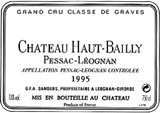
Classification: Classified growth (for reds only)
Owner: Robert G. Wilmers
Address: 103, route de Cadaujac, 33850 Léognan
Telephone: 05 56 64 75 11; Telefax: 05 56 64 53 60
E-mail: mail@chateau-haut-bailly.com
Website: www.chateau-haut-bailly.com
Visits: By appointment only
Contact: Véronique Sanders
VINEYARDS (RED)
Surface area: 79 acres
Grape varietals: 65% Cabernet Sauvignon, 25% Merlot, 10% Cabernet Franc
Average age of vines: 35 years
Density of plantation: 35 vines per hectare
Average yields: 40–45 hectoliters per hectare
Elevage: Three-week fermentation and maceration in temperature-controlled vats. Fifteen months aging in barrels with 50–60% new oak. Fining, no filtration.
RED WINES PRODUCED
Château Haut-Bailly: 80,000–100,000 bottles
La Parde de Haut-Bailly: 40,000–60,000 bottles
Plateau of maturity: Within 5–20 years of the vintage
GENERAL APPRECIATION
Haut-Bailly encountered some difficulties in the 1990s but is back on track. From their marvelous terroir, they fashion one of the lightest, most elegant offerings from Pessac-Léognan. As I have learned (the hard way), Haut-Bailly often tastes light and innocuous when young, but 5–7 years later, it is often significantly better, due primarily to the abundant Cabernet Sauvignon in the blend. Qualitatively, Haut-Bailly compares with a Médoc third growth.
By Graves standards, Haut-Bailly is a relative newcomer. The history, however, is not uninteresting. A Monsieur Bellot des Minières, who was the second owner of Haut-Bailly in 1872, apparently believed that the wine was greatly improved by the addition of copious quantities of cognac, which was left in the barrels after they were rinsed with this spirit. Today one hears rumors of Burgundy producers who fortify weaker vintages with eau-de-vie or brandy, but Monsieur Bellot des Minières was proud of his wine’s “extra” dimension.
The Sanders family became the proprietors in 1955. According to the family, Daniel Sanders—a wine enthusiast from Belgium—was so astounded by the 1945 Haut-Bailly that, after some investigation, he decided to buy the property. His son, Jean, who lives at the nearby estate of Château Courbon (which produces a pleasant, dry white Graves), managed the property after his father’s death. The property was sold to Robert G. Wilmers in July 1998.
Since the early 1960s Haut-Bailly has had an inconsistent track record for quality. The 1961 was fabulous, as was the delicious 1964, but it was not until 1979 that the quality began to bounce back after a prolonged period of mediocrity. The decision to relegate as much as 30% of the crop to a second wine, increase the percentage of new oak, and to harvest later in order to obtain riper grapes all resulted in increasingly better wines for Haut-Bailly during the 1980s.
When young, this is not the easiest wine to evaluate. I am not sure why, but it often comes across as a bit skinny and light yet seems to take on weight and depth in the bottle. When I asked Jean Sanders about this, he said he was not the least bit interested in making a wine to impress writers, particularly before it is bottled. He believes the extremely old age of his vineyard and his traditional winemaking style with absolutely no filtration result in a wine that requires some time to reveal all of its charm and character. Haut-Bailly will never have the size or power of its nearby neighbor de Fieuzal, but it does exhibit exceptional elegance in the top vintages.
IMPORTANT VINTAGES
ANCIENT VINTAGES (RED)
One of the sleeper vintages for Haut-Bailly, 1981 (89 points; last tasted 1/03) is clearly superior to the disappointing 1982. 1979 (88 points; last tasted 1/00) has always stood out as a pretty, elegantly styled example that showcases the telltale finesse and measured, restrained flavors of berry fruit, smoke, herbs, subtle oak, and minerals. It was still drinking beautifully when last tasted in January 2000. The 1982 was a major disappointment and continues to be an austere, washed-out wine with no intensity. Except for the 1970 (87 points; last tasted 10/88), the vintages of the 1970s were all disappointing. The 1964 (88 points; last tasted 3/90) and profound 1961 (93 points; last tasted 3/90) were top efforts, but I suspect they are both in decline. One of the most renowned Haut-Baillys is the 1928 (90 points), which was last tasted December 1995. At that time, it was in remarkable shape, and pristine bottles may be in far better shape than more recent vintages.
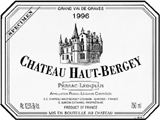
Classification: None
Owner: Sylviane Garcin-Cathiard
Address: 69, cours Gambetta, 33850 Léognan
Mailing address: BP 49, 33850 Léognan
Telephone: 05 56 64 05 22; Telefax: 05 56 64 06 98
E-mail: haut-bergey@wanadoo.fr
Visits: By appointment only
Contact: Hélène Garcin-Lévêque
VINEYARDS (RED)
Surface area: 56.8 acres
Grape varietals: 60% Cabernet Sauvignon, 40% Merlot
Average age of vines: 30 years
Density of plantation: 6,500 vines per hectare
Average yields: 35 hectoliters per hectare
Elevage: Fermentation with indigenous yeasts and prolonged maceration in temperature-controlled stainless-steel vats. Sixteen to eighteen months aging in barrels with 50% new oak. Fining, no filtration.
RED WINES PRODUCED
Château Haut-Bergey: 55,000 bottles
L’Etoile de Bergey: 20,000 bottles
Plateau of maturity: Within 5–15 years for post-1998 vintages
VINEYARDS (WHITE)
Surface area: 4.9 acres
Grape varietals: 65% Sauvignon, 35% Semillon
Average age of vines: 30 years
Density of plantation: 6,500 vines per hectare
Average yields: 35 hectoliters per hectare
Elevage: Fermentation and aging on lees in barrels with 30% new oak. Fining, filtration not systematic.
Château Haut-Bergey: 5,000 bottles
L’Etoile de Bergey blanc: variable
Plateau of maturity: Within 3–10 years of the vintage
GENERAL APPRECIATION
This is one of the most amazing quality turnarounds I have ever seen. In less than five years, Haut-Bergey (red) has gone from an obscure, indifferent wine to one of the stars of Pessac-Léognan. Credit should be given to the Garcin-Cathiard family, who are also behind the succession of inspiring efforts from both Clos l’Église in Pomerol and Barde-Haut in St.-Emilion, and responsible for the vin de garage Branon that emerges from part of this vineyard.
Château Haut-Bergey is a beautiful estate dating back to the 16th century. However, it was not until it was acquired in the 1990s by the Garcin-Cathiard family (who also own the Pomerol estate of Clos l’Église) that it began to produce interesting wine. Not surprisingly, in Pomerol, the owners utilize the services of Michel Rolland, and for Haut-Bergey, they use both Michel Rolland and Jean-Luc Thunevin, two of the most highly respected wine consultants in Bordeaux, if not the world. This is akin to being tutored on foreign policy by Condoleezza Rice and Henry Kissinger.
IMPORTANT VINTAGES (RED)
2001 |
The 2001 Haut-Bergey’s saturated ruby/purple–colored 2001 boasts intense aromas of melted road tar, licorice, tobacco, smoke, and copious black cherry/currant fruit. New oak also makes an appearance. With supple tannin, a rich, layered texture, medium to full body, and outstanding purity as well as length, this is a tremendous success, especially given the vintage conditions. Anticipated maturity: 2006–2016. Last tasted, 1/03. |
2000 |
A stunning achievement from this unheralded vineyard, the saturated ruby/purple–colored 2000 displays a striking perfume of cigar smoke, scorched earth, roasted espresso, and black cherry/currant fruit. It possesses luxurious richness, medium to full body, sweet tannin, and a seamless, silky-textured finish that lasts for nearly 45 seconds. This brilliant achievement satisfies both the hedonistic and intellectual senses. Moreover, it is a good value, and surprisingly accessible in spite of its density. Anticipated maturity: 2005–2020. Last tasted, 1/03. |
1999 |
A classic Graves, the 1999 Haut-Bergey is extraordinarily complex aromatically, light on its feet in the mouth, as well as a model of elegance and symmetry. The color is dark ruby, and the splendid nose reveals notes of cigar tobacco intermixed with plum, cherry, and currant fruit, grilled herbs, and roasted nuts. It is medium bodied, with sweet fruit on the attack, and an expansive Burgundian-like finish with light tannin and enough acidity to provide grip, freshness, and delineation. This terrific effort needs to be consumed during its first 7–8 years of life. Last tasted, 3/02. |
1998 |
Elegant, spicy, tobacco, cranberry, and red cherry characteristics emerge from this finesse-styled, sweet, flavorful, medium-bodied wine. Already delicious as well as complex, it is best consumed over the next 5–6 years. Last tasted, 3/02. |
Vintages prior to 1998 are of little interest to quality-conscious wine buyers.
IMPORTANT VINTAGES (WHITE)
2001 |
The finest dry white yet produced by Haut-Bergey, this medium-bodied offering reveals notes of honeysuckle, grapefruit, citrus, candle wax, figs, and spicy oak. Ripe, dense, well delineated, and concentrated, it will be at its peak from now through 2014. Last tasted, 1/03. |
2000 |
Notes of freshly mown grass intermixed with citrus and lemon zest emerge from this very good, richly fruity, but straightforward white Graves. Enjoy it over the next 7–8 years. Last tasted, 1/03. |
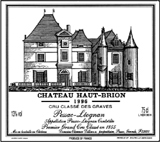
Classification: First classified growth in 1855
Owner: Domaine Clarence Dillon SA
Address: 135, avenue Jean Jaurès, 33600 Pessac
Mailing address: c/o Domaine Clarence Dillon, 33608 Pessac Cedex
Telephone: 05 56 00 29 30; Telefax: 05 56 98 75 14
E-mail: info@haut-brion.com or visites@haut-brion.com
Website: www.haut-brion.com
Visits: By appointment Monday to Thursday, 8:30–11:30 A.M. and 2–4:30 P.M.; Friday, 8:30–11:30 A.M.
Contact: Turid Hoel-Alcaras and Carla Kuhn
VINEYARDS (RED)
Surface area: 106.7 acres
Grape varietals: 45% Cabernet Sauvignon, 37% Merlot, 18% Cabernet Franc
Average age of vines: 36 years
Density of plantation: 8,000 vines per hectare
Average yields: 35–45 hectoliters per hectare
Elevage: Fermentation and maceration in temperature-controlled stainless-steel vats of 225-hectoliter capacity. Twenty-two months aging in new oak barrels. Fining, no filtration.
RED WINES PRODUCED
Château Haut-Brion: 132,000 bottles
Château Bahans Haut-Brion: 88,000 bottles
Plateau of maturity: Within 10–40 years of the vintage
VINEYARDS (WHITE)
Surface area: 6.7 acres
Grape varietals: 63% Semillon, 37% Sauvignon
Average age of vines: 36 years
Density of plantation: 8,000 vines per hectare
Average yields: 35 hectoliters per hectare
Elevage: Fermentation and 13–16 months aging in new oak barrels. No fining, no filtration.
WHITE WINES PRODUCED
Château Haut-Brion: 7,800 bottles
Les Plantiers du Haut-Brion: 5,000 bottles
Plateau of maturity: Within 5–30 years of the vintage
GENERAL APPRECIATION
A strong argument can be made that this great first growth is the world’s most elegant and aromatically complex wine. Since the early 1980s, no first growth has been as consistent or as brilliant in quality as Haut-Brion.
Located in the bustling commercial suburb of Pessac, Haut-Brion is also the only first growth to be American owned. The Dillon family purchased Haut-Brion in 1935 in very poor condition and invested considerable sums of money in the vineyards and wine cellars. This lovely property is now one of the showpiece estates of Graves.
The winemaking at Haut-Brion is managed by the articulate and handsome Jean Delmas (one of the wine world’s most gifted administrators), who fervently believes in a hot, short fermentation. As Bordeaux wines go, Haut-Brion is kept a long time (up to 30 months) in new oak barrels. Along with Château Margaux and Pavie, it is often the last château to bottle its wine.
The style of wine at Haut-Brion has changed over the years. The magnificently rich, earthy, almost sweet wines of the 1950s and early 1960s gave way in the period 1966–1974 to a lighter, leaner, easygoing, somewhat simplistic style of claret that lacked the richness and depth one expects from a first growth. Whether this was intentional or just a period in which Haut-Brion was in a bit of a slump remains a question in search of an answer. The staff at Haut-Brion is quick-tempered and sensitive about such a charge. Starting with the 1975 vintage, the wines have again taken on more of the customary earthy richness and concentration that existed during the 1966–1974 era. Haut-Brion today is undoubtedly making wine that merits its first-growth status. In fact, the wines from 1979 onward have consistently proven to be among the finest wines produced in the region, as well as a personal favorite.
Coincidence or not, the quality of Haut-Brion began to rebound from the 1966–1974 era in 1975 when the late Douglas Dillon’s daughter, Joan, became president of the company. After the death of her first husband, Prince Charles of Luxembourg, she married the Duc de Mouchy in 1978. It was at this time that the quantity of the crop relegated to Bahans Haut-Brion was increased, a practice that has irrefutably improved the quality of Haut-Brion. Moreover, it appears she gave Jean Delmas carte blanche authority and total responsibility for running the estate. As almost everyone in Bordeaux will acknowledge, Delmas is widely regarded as one of the most talented and knowledgeable winemakers/administrators in France, if not the world. His extraordinary state-of-the-art research with clonal selections is unsurpassed in France. With the advent of the super-abundant crops during the decade of the 1980s, Delmas began, much like his counterpart in Pomerol, Christian Moueix of Château Pétrus, to crop-thin by cutting off grape bunches. This has no doubt accounted for the even greater concentration, as well as the extraordinary quality, of the 1989, which may be the most compelling Haut-Brion made since the 1959 and 1961, and a modern-day legend.
It is interesting to note that in blind tastings Haut-Brion often comes across as the most aromatic as well as most forward and lightest of all the first growths. In truth, the wine is deceptive, and not all that light, but just different, particularly when tasted alongside the more oaky, fleshy, and tannic wines of the Médoc as well as the softer, Merlot-dominated wines from the right bank. Despite the precociousness, it has the ability to gain weight as well as texture, and to age for 30 or more years in top vintages, giving it a broader window of drinkability than any other first growth. Aromatically, a great vintage of Haut-Brion has no peers.
Accompanying the increased level of quality in Haut-Brion since 1975 has been the increased quality of the second label, Bahans Haut-Brion. This is now one of the best second wines of Bordeaux, surpassed in certain vintages only by the renowned second wine of Château Latour, Les Forts de Latour.
The white wine made at Haut-Brion continues to be rated the finest of the Graves region. However, at the request of the proprietors it has never been classified because the production is so tiny. Nevertheless, under Jean Delmas, who has sought to make a white Graves with the opulent texture of a prodigious Montrachet, the white wine has gone from strength to strength. Recent vintages such as 2001, 1998, 1994, 1989, and 1985 have been astonishing wines of majestic richness and complexity.
On a personal note, I should also add that after more than 30 years of intensely tasting as many Bordeaux wines as I can, the only general change I have noticed in my taste has been a greater and greater affection for Haut-Brion. The smoky, mineral, cigar box, sweet black currant character of this wine has increasingly appealed to me as I have gotten older and, as Jean Delmas would undoubtedly state, wiser as well.
IMPORTANT VINTAGES (RED)
ANCIENT VINTAGES (RED)
Between 1966 and 1974, Haut-Brion’s track record is far less successful than one would suspect based on what they achieved between 1975 and 2002. The 1970 (85 points; last tasted 6/96) has always been an understated, somewhat straightforward wine with the telltale perfume but never a lot of complexity, depth, or intensity. The same could be said for the 1966 (88 points; last tasted 12/00). This wine has consistently been a mid- to upper-80-point wine, showing earthy, tobacco, and herbal notes in a light-to medium-bodied, relatively austere style. The wine is fully mature, but has the structure and freshness to last another 5–10 years. Certainly the 1964 (90 points; last tasted 10/88) has always performed in an outstanding but somewhat more rustic style than one expects from Haut-Brion. The 1962 is an elegant beauty of finesse and sweetness (90 points; last tasted 12/00). Of course, the two immortal wines are the 1961 (100 points; last tasted 1/01) and 1959 (100 points; last tasted 9/02). Both of these wines are extraordinary, with the 1961 seemingly at the end of its plateau of maturity, and the 1959 showing no signs of weakness and capable of lasting another 10–15 years. Both are extraordinary Haut-Brions that are pure perfection from pristine bottles, with the classic nose of cedar, tobacco, minerals, sweet red and black fruits, and an extremely full-bodied, opulent texture. The 1959 is a bit more viscous and probably has more in common with the 1989 than the 1961.
In January 1997, I had the exceptionally smoky, sweet, rich, impressively endowed 1957 Haut-Brion (90 points). The wine was fully mature, as evidenced by its dark garnet color with considerable rust. The wine was very aromatic, plump, and succulently textured, with fleshy flavors, plenty of glycerin, and sweet fruit. It is another example of an unheralded vintage producing a top-flight wine. A dark ruby–colored wine with noticeable amber/rust, the 1955 Haut-Brion (97 points; last tasted 1/03) offers a huge, fragrant bouquet of walnuts, tobacco, wet stones, and smoky, cassis-like fruit. Medium bodied, with extraordinary elegance and sweetness, this rich, concentrated wine exhibits no hard edges. Remarkably youthful, as well as concentrated and impeccably well balanced, it is capable of lasting for another 10–20 years. Haut-Brion’s 1953 (95 points; last tasted 10/94) is best purchased today in magnums or larger-format bottles. Although it has been fully mature for decades, it has retained the hallmark, singed leather, tobacco leaf, superripe fragrance that makes Haut-Brion so distinctive. The wine is extremely soft, revealing considerable amber and rust at the edge, but it still possesses rich, creamy fruit and medium to full body. It does require drinking, so be very careful with regular-size bottles.
The 1949 Haut-Brion (91 points; tasted 12/95) revealed some of the textbook cigar, ashtray, tobacco-scented notes, as well as scents of roasted herbs and ripe fruit. The color was a medium garnet with considerable rust at the edge. Medium bodied, round, sweet, and soft, this wine is past its prime, although it remains exceptional. Drink it up. Neither Haut-Brion’s 1948 nor 1947 have ever left me with a favorable impression. The 1948 (75 points; last tasted 3/97), from a private cold cellar in Bordeaux, was attenuated, muddled, and extremely disjointed and unimpressive. Several tastings of the 1947 (my birth year) have always been too alcoholic, with high levels of acidity and not enough fruit and flesh to cover the wine’s imposing structural components. The 1945 (100 points; last tasted 10/94) Haut-Brion is profound. It demonstrates the essence of Haut-Brion’s style. The color remains a healthy, opaque garnet with only slight amber at the edge. A huge, penetrating bouquet of sweet black fruits, smoked nuts, tobacco, and tar soars from the glass. The wine possesses extraordinary density and extraction of fruit, massive, full-bodied, unctuously textured flavors that reveal little tannin, and copious quantities of glycerin and alcohol. It is a fabulously rich, monumental example of a fully mature Haut-Brion that exhibits no signs of decline. Awesome! One of my more interesting tasting experiences was Haut-Brion’s 1943 (89 points; last tasted 1/97). 1943 was believed to be the finest vintage of the World War II years. This wine, bottled after the war ended, exhibited a deep garnet color and a scorched earth/melted tar/aged beef-like aroma. The provocative aromatics were followed by a wine with copious quantities of sweet fruit, astringent tannin, and a dry, angular finish. Extremely complex, with most of the fruit remaining on the attack, this wine is just beginning to narrow out and become more austere and angular.
The 1937 vintage has a justifiable reputation for being hard, but one could see through the austere, still tannin-dominated 1937 Haut-Brion (89+? points; tasted 12/95) to admire the healthy, dark, dense color with only some amber at the edge. Minerals, tobacco, cedar, and coffee aromas were followed by a muscular, medium-bodied wine with plenty of power and fruit. But the vintage’s telltale hard tannin was still present. This particular magnum of 1937 Haut-Brion would have lasted another 20–30+ years. I had mixed tasting notes on the 1928 (anywhere from 96–100 points; last tasted 8/02). At its best, it is the most concentrated, port-like wine I have ever tasted from Haut-Brion. Its huge, meaty, tar, caramel, and jammy black fruit character is unctuously textured. The wine oozes out of the glass and over the palate. In some tastings it has been overripe, yet healthy and intact, but nearly bizarre because of its exaggerated style. There is a timeless aspect to it. The 1926 vintage, one of the best years in the decade of the 1920s, has always been overlooked in favor of the 1929, 1928, and 1921. Reputed to be one of the great wines of the vintage, the 1926 Haut-Brion (97 points; last tasted 10/94) is unusual in its roasted, chocolaty, sweet, dense, thick style. It reveals an impressive deep color with some orange at the edge and a huge nose of tobacco, mint, chocolate, grilled nuts, and smoked duck. Full-bodied and powerful, with amazing thickness and unctuosity, but extremely tannic and rustic, this atypical Haut-Brion will last for another 20–30 years. The 1921 Haut-Brion (79 points; last tasted 12/95) possessed a dense, impressive color, extremely high tannin levels, and an old, sweaty, leathery, locker-room nose with vague coffee and chocolaty, roasted herb-like flavors. The astringent tannin gave the wine a coarse and disjointed personality.
IMPORTANT VINTAGES (WHITE)
2001 |
This dense, full-bodied, concentrated, lively Haut-Brion blanc exhibits aromas of honeyed citrus, flowers, smoke, and melon. It should age marvelously for three decades. Anticipated maturity: 2005–2030. Last tasted, 1/03. |
2000 |
An outstanding effort for the vintage, although shy when compared to the 2001 or evolved, complex 1999, the 2000 reveals a rich lanolin and honeyed melon bouquet with a hint of fig in the background. Made in a medium-bodied, straightforward style with loads of fruit, glycerin, and smoky wood, but not the nuances, persistence, and depth of the 2001 or 1999, it can be drunk now and over the next 12 years. Last tasted, 1/03. |
1999 |
A beautiful Haut-Brion blanc, the 1999 has put on considerable weight. It reveals characteristics of dried herbs, olives, smoke, buttery citrus, grapefruit, and a hint of orange skin. The wine is medium bodied, with good acidity as well as a luscious flavor profile. Anticipated maturity: now–2020. Last tasted, 1/03. |
1998 |
A prodigious example, the 1998 tastes like liquid minerals intermixed with honeyed grapefruit, lanolin, citrus, smoke, and passion fruit. Full-bodied, with good acidity, plenty of structure, and a tremendously long finish, it remains youthful and tight, but the upside is awesome. Anticipated maturity: 2007–2035. Last tasted, 1/03. |
This opulent, full-bodied, flashy, flamboyant, evolved Haut-Brion blanc exhibits a light gold color in addition to deep, concentrated, honeysuckle, lanolin, orange peel, and white peach aromas as well as flavors. This opulent, viscous 1997 can be drunk now and over the next 15–20 years. Last tasted, 1/03. |
|
1996 |
In a vintage that produced a lot of high acid, emaciated dry whites, Haut-Brion’s 1996 is the wine of the vintage. It displays exceptional concentration, tangy acidity, and gorgeously layered flavors of buttery citrus-like fruit, olives, and smoke. This medium-bodied, concentrated wine is quite backward. It will need a considerable amount of bottle age to shed some of its structure. Anticipated maturity: 2010–2025. Last tasted, 11/97. |
1995 |
In this vintage, the Haut-Brion blanc contained less Semillon because Jean Delmas thought the drought had negatively impacted this varietal more than Sauvignon. Consequently, the 1995 is less grandiose in its proportions but still one of the two best dry white Graves of the vintage. The wine possesses a light gold color, and a citrusy, honeyed nose with subtle toasty oak. Medium bodied, with exquisite concentration and delineation, this beautifully pure wine can be expected to close down and not reemerge from its dormant stage for a decade. Anticipated maturity: 2007–2025. Last tasted, 11/97. |
1994 |
This spectacular dry white Graves is a likely candidate to rival the 1989 produced at Haut-Brion. The harvest began at the end of August. The wine possesses the texture of a great Burgundy grand cru given its thick unctuousness. The superb nose of honeyed fruits and smoky oak is far more developed and ostentatious than its sister, the more subtle and backward Laville Haut-Brion. Awesomely rich, with a chewy texture and great purity and definition, this is a ravishingly intense, full-bodied, dry white wine that should age well for 30+ years. Last tasted, 7/97. |
1993 |
Slightly superior to the sensational 1992 Haut-Brion blanc, the 1993 exhibits a flattering nose of oily, mineral-scented, ripe, honeyed fruit, full-bodied, super-concentrated flavors, admirable acidity, great vibrancy and delineation, and a rich, long, dry, refreshing finish. It is a rich Haut-Brion blanc with more aromatic complexity than the muscular and chewy 1992. These wines are almost ageless. Like its older sibling, the 1993 will age effortlessly for 20–30 years. Last tasted, 11/94. |
1992 |
This is another blockbuster Haut-Brion blanc, with a big, ostentatious bouquet of sweet, honeyed fruit. Full-bodied, with layers of richness, this creamy-textured, fleshy wine is at present more evolved and dramatic than its sibling, the 1992 Laville. The wine possesses fine acidity and an explosively long, dry finish. This dazzling Haut-Brion blanc should drink well for 30+ years. Last tasted, 1/94. |
1989 |
This is the most immense and large-scaled Haut-Brion blanc I have ever tasted. Jean Delmas, administrator of the Dillon properties, justifiably felt the 1989 fully replicated the fleshy, chewy texture of a great grand cru white Burgundy. Only 600 cases were made of this deep yellow/gold-colored, rich, alcoholic, sumptuous wine. It is amazingly full and long in the mouth, with a very distinctive mineral, honeyed character. The low acidity would seemingly suggest a shorter life than normal, but I am convinced this wine will last 25 or more years. It is a real show-stopper! Sweet, honeyed peach, caramel, and buttery aromas tumble from the glass of this prodigious effort. Anticipated maturity: now–2025. Last tasted, 1/03. |
ANCIENT VINTAGES (WHITE)
This wine can last for four decades, but I have had little opportunity to taste older vintages. One of the most remarkable vintages I have tasted is the 1985 (98 points; last tasted 12/00).
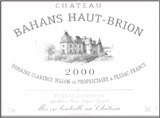
IMPORTANT VINTAGES
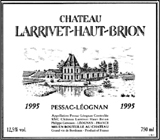
Classification: Grand Cru de Graves
Owner: Philippe Gervoson
Address: 84, route de Cadaujac, 33850 Léognan
Mailing address: BP 41, 33850 Léognan
Telephone: 05 56 64 75 51; Telefax: 05 56 64 53 47
Visits: By appointment Monday to Friday, 8:30–noon and 1:30–5 P.M.
Contact: Christine Gervoson or Jocelyne Duval
VINEYARDS (RED)
Surface area: 111.2 acres
Grape varietals: 50% Cabernet Sauvignon, 50% Merlot
Average age of vines: 20 years
Density of plantation: 7,692 vines per hectare
Average yields: 45 hectoliters per hectare
Elevage: Twenty-one to twenty-eight day fermentation and maceration. Eighteen months aging in barrels with 60–70% new oak. No fining, filtration.
RED WINES PRODUCED
Château Larrivet-Haut-Brion: 100,000 bottles
Domaine de Larrivet: 100,000 bottles
Plateau of maturity: Within 8–20 years of the vintage
VINEYARDS (WHITE)
Surface area: 22.2 acres
Grape varietals: 60% Sauvignon Blanc, 35% Semillon, 5% Muscadelle
Average age of vines: 15 years
Density of plantation: 7,692 vines per hectare
Average yields: 40 hectoliters per hectare
Elevage: Fermentation and 12 months aging on lees in new oak barrels. Fining and filtration.
WHITE WINES PRODUCED
Château Larrivet-Haut-Brion: 30,000 bottles
Domaine de Larrivet: 20,000 bottles
Plateau of maturity: Within 5–15 years of the vintage
Larrivet-Haut-Brion’s owners, Christine and Philippe Gervoson, have done considerable work restoring this beautiful estate to the list of serious Bordeaux wine producers. Like Malartic-Lagravière, Haut-Bergey, and Picque Caillou, this Pessac-Léognan property has demonstrated a renewed commitment to quality, and thus the wines have improved significantly after a long period of mediocrity. Post-1998, all vintages merit attention.
Larrivet-Haut-Brion is well known in European wine circles but until recently was rarely seen in America. The vineyard, located in the southern section of Graves near Léognan, is adjacent to that of the much more famous Haut-Bailly. This beautiful estate, with an attractive château sitting among trees in a shady, park-like atmosphere, has improved dramatically over the last five or so years. The famed Libourne oenologist, Michel Rolland, was brought in and has instituted a strict selection process as well as a later harvest, resulting in the finest wines I have ever tasted from Larrivet-Haut-Brion. This is a property with tremendous upside potential as the vineyards are a respectable age and are planted on pure gravelly soil.
IMPORTANT VINTAGES (RED)
2001 |
A stylish, gracious offering, the 2001 Larrivet-Haut-Brion offers sweet black cherry and currant fruit intermixed with tobacco, smoke, dried Provençal herbs, and a touch of new oak. There is great fruit on the attack, admirable sweetness, wonderful freshness and liveliness, medium body, and an undeniably elegant, pure style. Lighter than the 2000, but beautifully etched, it should be at its best between 2006 and 2015. Last tasted, 1/03. |
2000 |
The deep ruby/purple–colored 2000’s rich, complex perfume displays aromas of cocoa, black cherry liqueur, melted licorice, scorched earth, espresso, and new oak. The wine is rich, firm, tannic, concentrated, and full-bodied with admirable sweetness of fruit. It is a beautiful effort that should be drinkable between 2007 and 2020. Last tasted, 1/03. |
1999 |
Complex aromas of scorched earth, Provençal garrigue notes, and black cherries dominate this perfumed, sexy effort. Medium-bodied, with serious concentration, moderate tannin, and a long finish, this plum/garnet-colored wine will benefit from 1–2 more years of cellaring. Anticipated maturity: 2005–2015. Last tasted, 3/02. |
1998 |
Classic scents of smoky tobacco, cigar box, scorched earth, black currants, and cherries are vividly displayed in this wine’s intense aromas. In the mouth, it is medium bodied, spicy, soft, as well as expressive. This elegant beauty will keep until 2015. Last tasted, 3/02. |
1997 |
Spicy, peppery, Provençal garrigue, smoky aromas, sweet fruit, attractive ripeness, low acidity, and fine concentration characterize this easygoing, dark ruby–colored wine. Consume it over the next 3–4 years. Last tasted, 3/01. |
1996 |
I was seduced by the 1996 Larrivet-Haut-Brion. Although not a powerhouse, it is medium bodied, with expressive tobacco-tinged black currant fruit, a succulent, velvety texture, and smoky, expressive aromatics and flavors. This stylish, evolved 1996 can be drunk now and over the next 5–6 years. Last tasted, 3/01. |
ANCIENT VINTAGES (RED)
Virtually everything produced before 1996 was rated between the low 70s and low 80s. The tasting notes were equally unimpressive. Undoubtedly the efforts of owners Christine and Philippe Gervoson as well as their winemaking staff have elevated Larrivet-Haut-Brion to one of the most exciting wines of Pessac-Léognan. They are now exploiting the full potential of this beautifully situated vineyard. Vintages from the 1980s, 1970s, and 1960s should be approached with considerable caution.
IMPORTANT VINTAGES (WHITE)
2001 |
A gorgeous perfume of smoked herbs, toast, honeyed melon, and citrus fruit jumps from the glass of this medium-bodied, elegant, tangy 2001. It possesses good acidity, excellent definition, and intense flavors. A beauty, it is the finest white Larrivet-Haut-Brion I have tasted. Anticipated maturity: now–2012. Last tasted, 1/03. |
2000 |
Notes of melons are present in this citrusy, medium-bodied, pleasant but undistinguished effort. While it pales in comparison to the brilliant 2001, it is an easygoing white Graves to consume during its first 8–10 years of life. Last tasted, 1/03. |
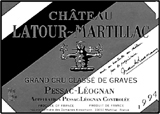
Classification: Classified growth (for reds and whites)
Owner: Kressmann family
Address: Chemin de la Tour, 33650 Martillac
Telephone: 05 57 97 71 11; Telefax: 05 57 97 71 17
E-mail: latour-martillac@latour-martillac.com
Website: www.latour-martillac.com
Visits: By appointment Monday to Friday, 10 A.M.–12:30 P.M. and 1–5 P.M.
Contact: Tristan Kressmann
VINEYARDS (RED)
Surface area: 74.1 acres
Grape varietals: 60% Cabernet Sauvignon, 35% Merlot, 5% Cabernet Franc, Malbec, Petit Verdot
Average age of vines: 35 years
Density of plantation: 7,500 vines per hectare
Average yields: 45 hectoliters per hectare
Elevage: Fermentation and maceration in temperature-controlled vats. Eighteen months aging in barrels with 50% new oak. Fining, no filtration.
RED WINES PRODUCED
Château Latour-Martillac: 120,000 bottles
Lagrave-Martillac: 30,000–40,000 bottles
Plateau of maturity: Within 5–18 years of the vintage
VINEYARDS (WHITE)
Surface area: 24.7 acres
Grape varietals: 55% Semillon, 40% Sauvignon Blanc, 5% Muscadelle
Average age of vines: 40 years
Density of plantation: 7,500 vines per hectare
Average yields: 48 hectoliters per hectare
Elevage: Fermentation and 15 months aging on lees with regular stirring in oak barrels with 50% new oak. Fining, no filtration.
WHITE WINES PRODUCED
Château Latour-Martillac: 30,000 bottles
Lagrave-Martillac: 15,000 bottles
Plateau of maturity: Within 5–15 years of the vintage
GENERAL APPRECIATION
While the whites of this estate have always been good, especially since the mid-1980s, the reds were too often innocuous and blatantly oaky. Things have changed over recent years (since Michel Rolland has been brought in as a consultant) and post-1998 vintages have shown a marked improvement over their predecessors. While soundly made, thereby meriting consumers’ attention, the wines of Latour-Martillac are still somewhat of a work in progress.
By the standards of other Graves properties, Latour-Martillac is not an old estate, as the history of the vineyard traces only to the mid-19th century. However, it has been owned by one of Bordeaux’s most famous families, the Kressmanns, since 1930, and is now managed by Tristan Kressmann.
IMPORTANT VINTAGES (RED)
2001 |
This well-made, attractive 2001 displays a bit too much new oak, but it exhibits lovely notes of black currant fruit intermixed with licorice, menthol, and spice box. Elegant, clean, and sweet, it should be drinkable early. Anticipated maturity: 2005–2014. Last tasted, 1/03. |
2000 |
The finest Latour-Martillac I have ever tasted, this evolved, dense ruby/purple–colored 2000 offers a big, sweet, flamboyant bouquet of cedar, mulberries, black currants, and smoke. Medium to full-bodied, ripe, concentrated, and substantial, this impressive effort should be at its finest between 2005 and 2016. Last tasted, 1/03. |
1999 |
This elegant 1999 reveals a heavy dosage of wood, but it also possesses briery currant fruit, medium weight, and fine purity. Drink it over the next 7–8 years. Last tasted, 1/02. |
1998 |
A concentrated effort for this estate, the 1998 Latour-Martillac exhibits sweet, toasty, black currant fruit intertwined with tar and earth scents. With ripe tannin, medium body, and fine balance, this excellent wine should drink well between now and 2016. Last tasted, 1/02. |
1997 |
The 1997 is a rich, sweet wine with color, extract, and length. It offers smoky, toasty oak in the nose, attractive black currant fruit, and notes of licorice. It should drink well for 7–8 years. Last tasted, 3/00. |
1996 |
Latour-Martillac’s 1996 is a medium-bodied, straightforward wine with good spice, moderate fruit, and a simple personality. There is some tannin, but the wine is light. Anticipated maturity: now–2008. Last tasted, 3/00. |
An olive, tobacco, smoky, red currant, and cherry-scented nose is followed by an elegant, medium-bodied, soft, smoothly textured wine that can be drunk now or over the next 5 years. Last tasted, 11/97. |
IMPORTANT VINTAGES (WHITE)
2001 |
A strong effort, this honey, grapefruit, and citrus-filled white possesses medium body, smoky oak, a touch of minerality, fine acidity, and a long finish. It should drink well for 10–15 years. Last tasted, 1/03. |
2000 |
Typical of this vintage (which produced great reds but average-quality whites), the dull, monolithic 2000 Latour-Martillac reveals nice fruit on the attack, but it falls off quickly in the mouth. Drink it over the next 7–8 years. Last tasted, 1/03. |
ANCIENT VINTAGES (WHITE)
Latour-Martillac’s whites have shown well in many vintages, including 1994 (90 points; last tasted 3/97), 1992 (90 points; last tasted 1/94), 1989 (89 points; last tasted 11/00), and a brilliant 1988 (90 points; last tasted 11/88).
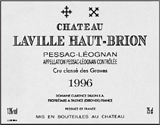
Classification: Classified growth (for whites)
Owner: Domaine Clarence Dillon SA
Address: 33400 Talence
Mailing address: c/o Domaine Clarence Dillon, Château Haut-Brion, 33608 Pessac Cedex
Telephone: 05 56 00 29 30; Telefax: 05 56 98 75 14
E-mail: info@haut-brion.com
Website: www.laville-haut-brion.com
No visits
VINEYARDS (WHITE)
Surface area: 9.1 acres
Grape varietals: 70% Semillon, 27% Sauvignon, 3% Muscadelle
Average age of vines: 51 years
Density of plantation: 10,000 vines per hectare
Average yields: 35 hectoliters per hectare
Elevage: Fermentation and 13–16 months aging in new oak barrels. No fining, no filtration.
WHITE WINES PRODUCED
Château Laville Haut-Brion: 10,200 bottles
No second wine is produced.
Plateau of maturity: Within 10–45 years of the vintage
Laville Haut-Brion is one of the world’s greatest dry white wines. It has an uncanny ability to improve for 30–40 years.
This tiny vineyard produces one of the most remarkably long-lived white wines of France. The soil is less gravelly and heavier than the vineyard of La Mission Haut-Brion. The production is tiny, adding to the rarity value of this white wine. Fermented and aged in new oak casks, Laville Haut-Brion takes on a waxy richness with aging. It is marvelous to taste from cask, but after bottling, it completely closes up, not to reopen in some instances for 5–10 years. Reputation and a consistent high level of quality ensure that it sells for a frighteningly high price. Perhaps that explains why 95% of the production is exported.
IMPORTANT VINTAGES (WHITE)
ANCIENT VINTAGES
The 1983 Laville Haut-Brion (90 points; last tasted 12/02) is an elegant, classy, textbook Laville, whereas the 1982 (87 points, last tasted 4/00) is a chunky, foursquare, heavyweight Laville that lacks the finesse and elegance of the 1983. Older vintages I have tasted include a powerhouse, now fully mature 1976 (91 points, last tasted 6/99), a classic, long-lived, tightly knit, well-structured 1975 (90 points, last tasted 8/00), a glorious 1966 (92 points, last tasted 8/00) and a 1962 (88 points, last tasted 8/00). In 1990 I finally had a chance to taste the Laville Haut-Brion that Michael Broadbent dubbed spectacular, the 1945 “Crème de Tête.” In a blind tasting against the regular cuvée of the 1945 Laville Haut-Brion, there was indeed a difference. The wines were stunning efforts that resembled old, powerful Sauternes more than white Graves. Both were massive, rich, honeyed wines that were quite dry, but because of their richness and fullness, they had overwhelming impact on the palate. The Crème de Tête clearly was richer and fuller. I rated it a 93.
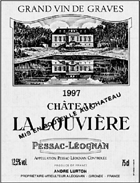
Classification: Unclassified
Owner: André Lurton
Address: route de Cadaujac, 33850 Léognan
Mailing address: Vignobles André Lurton, Château Bonnet, 33420 Grézillac
Telephone: 05 57 25 58 58; Telefax: 05 57 74 98 59
E-mail: andrelurton@andrelurton.com
Website: www.andrelurton.com
Visits: By appointment Monday to Friday, 9 A.M.–5 P.M.
Contact: Véronique Bouffard
VINEYARDS (RED)
Surface area: 82.7 acres
Grape varietals: 64% Cabernet Sauvignon, 30% Merlot, 3% Cabernet Franc, 3% Petit Verdot
Average age of vines: 20–22 years
Density of plantation: 6,500–8,500 vines per hectare
Average yields: 45 hectoliters per hectare
Elevage: Three-week fermentation and maceration in temperature-controlled stainless-steel vats. Twelve months aging in barrels with 50–75% new oak and racking every three months. Fining and filtration.
RED WINES PRODUCED
Château La Louvière: 150,000 bottles
L de la Louvière: 80,000 bottles
Plateau of maturity: Within 3–15 years of the vintage
VINEYARDS (WHITE)
Surface area: 33.3 acres
Grape varietals: 85% Sauvignon Blanc, 15% Semillon
Average age of vines: 20–22 years
Density of plantation: 6,500–8,500 vines per hectare
Average yields: 45 hectoliters per hectare
Elevage: After cold settling, 10–15 day fermentation (at 18–23°C) in barrels with 30–50% new oak. One year aging on lees with regular stirrings. Fining and filtration.
WHITE WINES PRODUCED
Château La Louvière: 50,000 bottles
L de La Louvière: 30,000 bottles
Plateau of maturity: Within 2–8 years of the vintage
As could be expected from an André Lurton estate, La Louvière offers one of the most consistently well-made wines of Pessac-Léognan, as well as one of the better values . . . in both red and white. It could easily compete with many a classified growth of the appellation.
While unclassified, La Louvière (which can trace its origins to 1200) is now making wines superior to many of the crus classés. In particular, recent vintages have been on a quality level with a Médoc fourth growth. The proprietor, André Lurton, acquired the property in 1965 and has thoroughly rejuvenated the estate, which has its vineyards impressively situated between Haut-Bailly and Carbonnieux.
The emphasis is on producing wines of immediate drinkability, but also wines that are concentrated, fresh, and pure. Lurton has achieved all of that. While it used to be true that the red wines could not match the brilliance of the whites, that has changed since the mid-1980s, as both wines are now excellent. Moreover, La Louvière remains notoriously undervalued, so consumers still have an opportunity to stock up on some delicious high-quality wines that compete with many of the most renowned Graves properties.
This is another château well worth visiting. The building is classified as one of France’s historic monuments.
IMPORTANT VINTAGES (RED)
2001 |
La Louvière’s 2001 offers a dense opaque ruby/purple color as well as a smoky, earthy-scented perfume with plenty of black cherry and currant fruit. It is sweet on the attack, possesses a true mid-section, fine purity, and sweet tannin in the low-acid finish. Anticipated maturity: 2005–2016. Last tasted, 1/03. |
2000 |
A top-notch effort, this opaque ruby/purple–colored 2000 exhibits plenty of earthy, black currant, vanilla, graphite, licorice, and smoky cherry aromas as well as flavors. Medium bodied with sweet tannin, good acidity, and a long, concentrated finish, this is the finest La Louvière since the 1990. Anticipated maturity: 2005–2015. Last tasted, 1/03. |
1999 |
Although La Louvière tends to be consistently well made, the 1999 is light, lean, and underwhelming. The color is medium ruby, and the wine displays a lack of sweetness, texture, and richness. It will last for 4–5 years. Last tasted, 3/02. |
1998 |
An excellent dark ruby/purple–colored effort, the 1998 offers a classic scorched-earth, smoky, black cherry, and currant-scented bouquet. Medium bodied, with sweet tannin, well-integrated acidity, and excellent flavor as well as richness, it is a complex, textbook Graves. Anticipated maturity: now–2014. Last tasted, 3/02. |
1996 |
La Louvière’s dark ruby/purple–colored, ripe 1996 exhibits an excellent combination of sweet black currant fruit meshed with notes of Provençal olives, licorice, smoke, and toasty new oak. With medium to full body, excellent sweetness, and a layered, concentrated finish, this wine should be at its finest between now and 2015. Last tasted, 3/01. |
1995 |
An exceptionally seductive, open-knit 1995, La Louvière’s telltale tobacco, smoky, leafy, herb-tinged red and black currant fruit jumps from the glass of this aromatic wine. Exhibiting excellent ripeness, a supple texture, medium body, and a delicious, roasted fruitiness, this textbook Graves can be drunk now or over the next 7–8 years. Last tasted, 12/01. |
One of the sleepers of the vintage, the deep ruby/purple color and smoky, black currant, herb-tinged nose of the 1994 are provocative. Rich, powerful, and dense, with moderate tannin, excellent to outstanding concentration, and admirable purity, this is an impressively endowed wine for drinking between now and 2012. Last tasted, 3/96. |
|
1990 |
The 1990 exhibits a saturated purple/garnet color, an unevolved nose of black fruits, smoke, and grilled meats, full body, low acidity, and intense, concentrated fruit, all crammed into a layered, pure, sweet, fruity, ripe wine. Anticipated maturity: now–2010. Last tasted, 7/00. |
1989 |
Fully mature, the soft, well-developed 1989 displays a dark ruby/garnet color, with some lightening at the edge. The wine offers a ripe, curranty nose intertwined with scents of new oak, herbs, olives, and tobacco. Medium bodied and smoothly textured, this lush wine should drink well for another 4–5 years. Last tasted, 7/00. |
1988 |
Among the finest La Louvières I have tasted, the 1988 is a concentrated, well-balanced wine possessing a delectable roasted, cassis fruitiness that expands on the palate. Impressively concentrated, with an opulent texture and velvety tannins, this complete wine should provide delicious drinking over the next decade. Anticipated maturity: now. Last tasted, 1/93. |
IMPORTANT VINTAGES (WHITE)
2001 |
A superb effort, an evolved, complex nose of buttery melons intermixed with figs, dried herbs, minerals, and smoke is followed by a fruit-driven, medium-bodied wine with loads of glycerin, excellent depth, fine purity, and a persistent finish. It should drink well for a decade. Last tasted, 1/03. |
2000 |
A noteworthy effort in a challenging vintage for dry white wines, the 2000 La Louvière offers up scents of orange peel, smoke, dried herbs, and minerals. This medium-bodied, evolved example is best drunk over the next 5–6 years. Last tasted, 1/03. |
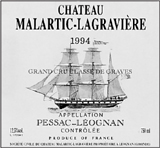
Classification: Classified growth (red and white)
Owner: Alfred-Alexandre Bonnie
Address: 43, avenue de Mont de Marsan, 33850 Léognan
Mailing address: BP 7, 33850 Léognan
Telephone: 05 56 64 75 08; Telefax: 05 56 64 99 66
E-mail: malartic-lagraviere@malartic-lagraviere.com
Website: www.malartic-lagraviere.com
Visits: By appointment only
Contact: Pascale Norton
VINEYARDS (RED)
Surface area: 91.4 acres
Grape varietals: 50% Merlot, 40% Cabernet Sauvignon, 10% Cabernet Franc
Average age of vines: 35 years
Density of plantation: 10,000 vines per hectare
Average yields: 25 hectoliters per hectare
Elevage: Three to five week fermentation and maceration in temperature-controlled stainless-steel vats. Fifteen to eighteen months aging in barrels with 40–80% new oak. Fining and filtration.
RED WINES PRODUCED
Château Malartic-Lagravière: 80,000 bottles
Le Sillage de Malartic: 80,000 bottles
Plateau of maturity: Within 5–15 years of the vintage
VINEYARDS (WHITE)
Surface area: 17.3 acres
Grape varietals: 80% Sauvignon Blanc, 20% Semillon
Average age of vines: 35 years
Density of plantation: 10,000 vines per hectare
Average yields: 25 hectoliters per hectare
Elevage: Fermentation and 8–12 months aging in barrels with 25% new oak. Fining and filtration.
WHITE WINES PRODUCED
Château Malartic-Lagravière: 60,000 bottles
Le Sillage de Malartic: 60,000 bottles
Plateau of maturity: Within 3–10 years of the vintage
GENERAL APPRECIATION
Under its present administration, Malartic-Lagravière has come to life. This once perennial underachiever has made an astonishing leap in quality since 1997, largely because of the efforts of new owners Alfred-Alexandre and Michèle Bonnie. Both reds and whites are now worthy of consumers’ interest and also remain reasonably priced. Visitors to Bordeaux may desire to schedule a visit, if only to see the space-age technology in the cuverie.
One of the numerous estates in the southern Graves region of Léognan, Malartic-Lagravière’s vineyard is a single parcel planted on the area’s high gravel terraces. Historically, the production per hectare at this estate has been high as the former proprietor, Jacques Marly, held the minority point of view that young vines and high yields produced a better wine than low yields and old vines.
With the acquisition of the estate by the Bonnie family in 1997, there has been a dramatic shift in the quality of the wines. Significant investments in a new, state-of-the-art, high-tech winemaking facility, more new oak, and the introduction of a stricter selection for the second wine quickly changed Malartic-Lagravière from being a largely ignored underachiever to one of the most elegant and interesting wines of Pessac-Léognan. This is clearly one of the region’s emerging stars. While the wines will never be blockbusters, both the reds and whites are models of elegance and definition. The higher quality began in 1997, and has been built on in each subsequent vintage. Moreover, prices have not yet caught up with the fascinating new offerings emerging from this estate.
IMPORTANT VINTAGES (RED)
2001 |
A sweet, soft, seductive effort, the 2001 Malartic-Lagravière is neither as concentrated as the 2000 nor as provocatively perfumed and charming as the 1999. Nevertheless, it is impressively made, particularly from a property that has enjoyed a complete renaissance in quality over the last four to five years. Sweet berry scents mix with leafy tobacco, smoke, and new oak in this dark ruby/purple–colored offering. Medium bodied, precise, pure, and seductive, it will drink well for 10–12 years. Last tasted, 1/03. |
2000 |
The finest Malartic-Lagravière yet produced, the dense ruby/purple–colored 2000 displays sweet aromas of plums, currants, tobacco, and smoke as well as abundant power, concentration, extract, glycerin, and length. This elegant, expansive, juicy, layered, medium-bodied effort should prove long-lived. Anticipated maturity: 2006–2020. Last tasted, 1/03. |
1999 |
A sleeper of the vintage, this sexy, open-knit, layered, dense ruby–colored 1999 is a light but delicious effort displaying super-sweet tobacco, black currant, and scorched-earth notes. Pure, with beautiful balance and pinpoint precision, it should be drunk during its first 10–12 years of life. This is a classic example of elegance and finesse that only Bordeaux can achieve. Last tasted, 3/02. |
1998 |
The 1998 represents a breakthrough effort for this property. The color is a dense, dark ruby/purple, and the nose reveals stylish, sweet black currant fruit intermixed with earth, minerals, licorice, and spice box. The wine is medium bodied, with ripe tannin, no hard edges, and a beautifully knit, concentrated finish that lasts for more than 30 seconds. Anticipated maturity: now–2015. Last tasted, 3/02. |
1997 |
Undoubtedly a sleeper of the vintage, this exceptionally charming, complex, elegant 1997 is neither big, weighty, nor powerful, yet it offers cedar, roasted herb, and sweet plum/cherry fruit in its aromas and flavors. The taster is seduced by the wine’s silky, seamless texture, gorgeous aromatics, low acidity, and lovely levels of fruit. It will not make old bones, but who cares since it is so endearing? Enjoy it over the next 3–4 years. Last tasted, 12/01. |
1996 |
The unsubstantial 1996 reveals a feeble light ruby color. It offers plenty of new oak and moderate cherry fruit in the nose, medium body, and a pleasant, straightforward, one-dimensional finish. The wine possesses tannin and structure, but not much extract or richness. Anticipated maturity: now–2010. Last tasted, 3/01. |
ANCIENT VINTAGES (RED)
Virtually nothing between the mid-1970s and 1995 merited a score above the low 80s. Even such top vintages as 1995 (76 points; last tasted 11/97), 1990 (73 points; last tasted 1/93), 1989 (82 points; last tasted 1/93), 1988 (77 points; last tasted 1/93), and 1985 (84 points; last tasted 3/90) were largely disappointing offerings produced under the previous administration. However, that is all in the past, and not indicative of the wines that have emerged from this estate since 1997.
2001 |
Crisp pea pod, fig, mineral, and smoky notes emerge from this delineated, medium-bodied, elegant, flavorful dry white Graves. It should drink well for 10–12 years. Last tasted, 1/03. |
2000 |
Muted grapefruit-like characteristics are present in this medium-bodied, foursquare 2000, which lacks the aromatic intensity and sparkle of its younger sibling. Drink it over the next 7–8 years. Last tasted, 1/03. |
1999 |
Honeyed citrus, melons, freshly mown grass, and cold steel characteristics are found in this light- to medium-bodied, dry, refreshing 1999. Consume it over the next 7–8 years. Last tasted, 1/03. |
1998 |
The first reassuringly top-flight white to emerge from this estate in many years, the 1998 exhibits aromas of honeyed grapefruit, citrus, smoke, peach skin, and toasty oak. Medium bodied, impressively concentrated, long, and pure, it should drink well for 10–12 more years. Last tasted, 1/03. |
ANCIENT VINTAGES (WHITE)
Under the administration of Jacques Marley, old vintages of this 100% Sauvignon Blanc–based wine were often extremely high in acidity, tart, herbaceous, and uninteresting. It could last for many years, but the distinctive aromas of underripe green peas and other vegetables was decidedly unappealing.
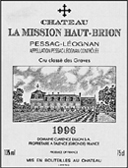
Classification: Classified growth (red wines)
Owner: Domaine Clarence Dillon SA
Address: 67, rue Peybouquey, 33400 Talence
Mailing address: c/o Domaine Clarence Dillon, Château Haut-Brion, 33608 Pessac Cedex
Telephone: 05 56 00 29 30; Telefax: 05 56 98 75 14
E-mail: info@haut-brion.com or visites@haut-brion.com
Website: www.mission.haut-brion.com
Visits: By appointment Monday to Thursday, 9–11:30 A.M. and 2–4:30 P.M.; Friday, 9 to 11:30 A.M.
Contact: Carla Kuhn
VINEYARDS (RED)
Surface area: 51.6 acres
Grape varietals: 45% Merlot, 48% Cabernet Sauvignon, 7% Cabernet Franc
Average age of vines: 21 years
Density of plantation: 10,000 vines per hectare
Average yields: 45 hectoliters per hectare
Elevage: Fermentation and maceration in temperature-controlled stainless-steel vats of 180-hectoliter capacity. Twenty months aging in new oak barrels. Fining, no filtration.
Château La Mission Haut-Brion: 72,000 bottles
La Chapelle de La Mission Haut-Brion: 36,000 bottles
Plateau of maturity: Within 8–50 years of the vintage
GENERAL APPRECIATION
The long-time cross-street rival of Haut-Brion has, since 1983, been under the same ownership/administration. Fears that the wine would change and become nothing more than the second wine of Haut-Brion have proven to be without merit. What is still evident is that La Mission Haut-Brion is a wine of first-growth quality, and its pricing policy reflects that. This is a great estate producing large-scaled, dense reds that represent the quintessential, full-bodied, scorched-earth Graves style. Moreover, the wines possess legendary aging potential. It is unquestionably one of the world’s most singular and distinctive wines. In essence, life is too short not to drink La Mission Haut-Brion.
La Mission Haut-Brion in Talence produces one of the greatest wines in the entire Bordeaux region. This estate sits across the road (RN 250), confronting its long-time rival, Haut-Brion, and has a record of virtually unmatched brilliance that covers much of the 20th century.
This estate has a long history, having been founded by the congregation of the Mission in the 17th century. Much of the wine was made for important members of the church. One of France’s most powerful historic figures, Richelieu (a La Mission devotée), was quoted as saying, “If God forbade drinking, would he have made such good wine?” As a result of the French Revolution, the estate was divested from the church and sold to a private buyer. The Woltner family acquired La Mission in 1919. It was they—particularly the late Frederic and his son Henri—who were responsible for the ascendancy of La Mission Haut-Brion’s wine quality to a level that matched and frequently surpassed the first growths of the Médoc and neighboring Haut-Brion.
Woltner’s genius was widely recognized in Bordeaux. He was known as a gifted taster and oenologist and pioneered the installation of easy-to-clean, metal, glass-lined fermentation tanks in 1926. Many observers attributed the dense, rich, powerful, fruity character of La Mission to these short, squat vats that, because of their shape, tended to increase the grape-skin-to-juice contact during the fermentation. These vats were replaced under the new administration with computer-controlled, state-of-the-art fermenters.
La Mission Haut-Brion’s style of wine has always been that of intense richness, full body, great color and extract, and plenty of tannin. I have had the pleasure of tasting all of the best vintages of La Mission back to 1921, and it is a wine that can easily last 30–50 years in the bottle. It has always been a much richer and more powerful wine than that of its one-time archrival Haut-Brion. For this reason, as well as remarkable consistency in poor and mediocre vintages (along with Latour in Pauillac, it has had the finest record in Bordeaux for good wines in poor vintages), La Mission had become one of the most popular wines of Bordeaux.
Henri Woltner passed away in 1974, and until the sale of La Mission Haut-Brion to the present owners of Haut-Brion in 1983, La Mission was managed by Françoise and Francis Dewavrin-Woltner. Internal family bickering over the administration of this property ultimately led to the sale of La Mission and two sister properties, La Tour Haut-Brion and the white wine–producing estate of Laville Haut-Brion. The Woltners settled in Napa Valley, where they produce wine from the steep hillsides of Howell Mountain.
Since 1983 Jean Delmas has moved quickly to stamp his winemaking philosophy on the wines of this estate. After the property was sold in 1983, the winemaking staff was promptly dismissed and Delmas began to augment the percentage of new oak that had deteriorated due to the financial difficulties experienced by the Woltner regime. Now La Mission, like Haut-Brion, is aged in 100% new oak. In addition, the amount of Merlot has been increased to 45%, with the amounts of both the Cabernet Sauvignon and Cabernet Franc lowered.
The first vintages under Delmas were very good but lacked the power and extraordinary richness seen in La Mission in previous top years. They were technically correct wines but lacked a bit of soul and personality. With the installation of a state-of-the-art winemaking facility at the estate in time for the 1987 vintage, the quality of the wine quickly returned to that of its glory years. The wine is cleaner, and flaws such as elevated levels of volatile acidity as well as rustic tannin that appeared in certain older vintages of La Mission are unlikely ever to rear their unpleasant heads under the meticulous management of Jean Delmas. Nevertheless, after a transitional period between 1983 and 1986, La Mission Haut-Brion returned in the late 1980s to produce one of the very best wines of the vintage in 1987, a beauty in 1988, and a sumptuous, perfect 1989, the latter wine undoubtedly the finest La Mission of the decade. Vintages of the 1990s, while more vexing because of rainy Septembers, have all produced wines that are among the finest in Bordeaux. Of course, the 2000 is immortal, the 1998 nearly so.
It is unlikely that the newer style of La Mission will age as long as older vintages, but neither will it be as unapproachable and tannic in its youth. In the final analysis, La Mission Haut-Brion remains a wine of first-growth quality.
IMPORTANT VINTAGES
La Mission Haut-Brion produced a good 1971 (87 points; last tasted 11/99) and a very irregular 1970 (largely because of high levels of volatile acidity and too many bottles that were defective and problematic). Among the vintages of the early and mid-1960s, the 1966 is excellent (89 points; last tasted 12/00), as are the 1964 (93 points; last tasted 2/02) and 1961 (100 points; last tasted 1/01). The argument will always be whether the 1961 or the 1959 (100 points; last tasted 1/03) is the greater vintage. The 1961 seems far more evolved and probably best drunk over the next 7–10 years, while the 1959 seems capable of lasting another 15–20 years. It is interesting to note that many 1959s, much like the 1982s, were maligned for lacking both acidity and aging potential. How does one explain the fact that many 1959s are less evolved, as well as richer, fresher, and more complete than many 1961s? For example, as great as the 1961 La Mission is, the equally perfect 1959 remains a less evolved and even richer, deeper-colored, more concentrated, and more powerful wine! It needs at least 3–5 more years of cellaring to reach its plateau of maturity. Spicy and super-concentrated, with a dense, plummy/purple color, this young, broodingly backward, formidably endowed wine should be at its best by the end of the century and drink well for the first 20–25 years of the next millennium. Even allowing for the greatness of Haut-Brion and Mouton Rothschild, the 1955 La Mission (100 points; last tasted 12/01) is the “wine of the vintage.” It possesses a sweet, cedary, clove, smoke, and black raspberry nose and rich, full-bodied, remarkably harmonious flavors that ooze with ripe fruit, glycerin, and heady alcohol. The tannin has totally melted away, and the wine reveals considerable rust at the edge, so it is unlikely that the 1955 will improve with further cellaring. There is no indication of any fragility or decline, so this wine can be safely drunk for 10–15 more years. It is an amazing, complex, superbly well-balanced La Mission Haut-Brion! I have been told by a number of people who have followed the 1953 (93 points; last tasted 10/94) vintage from its youth that it drank exceptionally well in the late 1950s. Apparently it has lost none of its hedonistic, supple, explosive fruit. It will not get any better, so consumption is recommended. It offers a delicious smoky, berry fragrance, a silky, creamy texture, and a long, heady finish. The low acidity provides vibrance, and the tannins have melted away. Should you be fortunate enough to have the beauty cellared, drink it over the next several years. La Mission also made a decent 1951 (81 points) and a great 1952 (93 points). Neither of these wines has been tasted since 1991. The 1950 (95 points; last tasted 10/94) possesses a huge nose of freshly brewed coffee, hickory wood, cedar, and chocolate. Superrich and dense, with little evidence of its age (the color is still an opaque dark garnet), this full-bodied, concentrated wine is at its apogee. It should continue to drink well for another 15–20 years.
The 1949 (100 points; last tasted 1/00) exhibits an intense, singed nose of roasted herbs, smoky black currant fruit, and grilled-meat aromas. Enormously rich yet sweet, soft, fat, and opulent, the fully mature 1949 La Mission is awesomely intense and long. It is a magnificent bottle of wine from the most harmonious Bordeaux vintage of the century. The 1948 (93 points; last tasted 3/01) offers up a powerful, roasted, rich bouquet of tobacco, ripe curranty fruit, and smoky chestnuts. It reveals no amber or brown, concentrated, highly extracted fruit, full body, and plenty of alcohol and tannin in the finish. The wine is clearly at its plateau of maturity and shows no signs of losing its fruit. It should last for another 10–20 years. A huge, port-like bouquet of chocolaty, cedary, earthy, plummy fruit demonstrates the extraordinary ripeness that was achieved in the 1947 (95 points; last tasted 12/02) vintage. Very alcoholic, powerful and rich, but at the same time velvety and sweet, this wine was probably as close to a late-harvest La Mission Haut-Brion as one is likely to experience. It is an exceptional wine with great flavor dimension and length. The 1945 La Mission (92? points; last tasted 6/00) is certainly a great wine with fabulous concentration but also a leathery, tough, hard texture. It is very powerful, broodingly rich and opaque, but the tannin is extremely elevated, and one wonders what is going to fall away first, the fruit or the tannin? This wine still has the potential to last for another 20–25 years, and therein lies much of the mystique of this vintage.
The extraordinary 1929 (97 points; last tasted 10/94) vintage—which may well have been the vintage of the century, with a style that old-timers compare to modern-day 1982s or, more recently, the 1990s—produced wines that were wonderfully opulent and unctuous. Henri Woltner wrote that the 1929 La Mission drank fabulously well in 1933, yet he doubted its ability to age well. How wrong he was! Still deep garnet in color, with only a trace of amber at the edge, this wine exhibits a fabulously exotic, sensual bouquet filled with aromas of tobacco, black currants, cedar, and leather. On the palate it reveals high alcohol, as well as the remarkably sweet, rich, expansive, staggering concentration of fruit necessary to stand up to the alcohol. This is a velvety, lush, full-bodied wine that it is an incredible privilege to drink.
IMPORTANT VINTAGES (LA CHAPELLE DE LA MISSION)
2001 |
The 2001 La Chapelle de la Mission exhibits supple tannin, and sweet black currant fruit intermixed with roasted herb and gravel-like scents. This elegant, medium-bodied offering will be delicious upon release and should drink well for 5–6 years. Last tasted, 1/03. |
2000 |
The 2000 La Chapelle de la Mission is surprisingly fat, juicy, and succulent, offering notes of roasted herbs, tobacco, black cherry and cassis fruit, scorched earth, and asphalt. This luscious second wine can be drunk now and over the next 12–15 years. Last tasted, 1/03. |
1999 |
A wonderful second wine, the 1999 La Chapelle offers sweet tobacco and currants in a smoky, straightforward, luscious style. Enjoy it over the next 5–6 years. Last tasted, 3/02. |
1998 |
Readers looking for a petite La Mission should check out the 1998 La Chapelle, a gorgeously complex, rich, Graves-styled wine with a smoky, tobacco, black currant, earthy-scented nose, fat, luscious, concentrated, seamless flavors, and beautifully integrated acidity and tannin. This fleshy, complex offering is already delicious, yet will last for 8 more years. Last tasted, 3/02. |
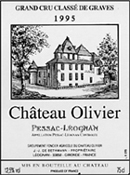
Classification: Classified growth (red and white)
Owner: Jean-Jacques de Bethmann
Address: 175, avenue de Bordeaux, 33850 Léognan
Telephone: 05 56 64 73 31 or 05 56 64 75 16; Telefax: 05 56 64 54 23
E-mail: chateau-olivier@wanadoo.fr
Website: www.chateau-olivier.com
Visits: By appointment only
Contact: Marie-France Héron
VINEYARDS (RED)
Surface area: 108.7 acres
Grape varietals: 50% Merlot, 40% Cabernet Sauvignon, 10% Cabernet Franc
Average age of vines: 25 years
Density of plantation: 7,500 vines per hectare
Average yields: 45 hectoliters per hectare
Elevage: Fermentation and three to four week maceration in temperature-controlled stainless-steel vats.
Twelve months aging in barrels with 33% new oak. Fining, no filtration.
RED WINES PRODUCED
Château Olivier: 180,000 bottles
Seigneurie d’Olivier: 60,000 bottles
Plateau of maturity: Within 5–15 years of the vintage
VINEYARDS (WHITE)
Surface area: 19.7 acres
Grape varietals: 50% Sauvignon Blanc, 50% Semillon
Average age of vines: 35 years
Density of plantation: 7,500 vines per hectare
Average yields: 45 hectoliters per hectare
Elevage: Fermentation and nine months aging in barrels with 33% new oak. No fining, filtration.
WHITE WINES PRODUCED
Château Olivier: 42,000 bottles
Seigneurie d’Olivier: 3,000 bottles
Plateau of maturity: Within 2–12 years of the vintage
GENERAL APPRECIATION
The latest vintages from Olivier have been the finest tasted from this one-time underachiever. After years of uninspiring performances, Olivier has begun to fashion more elegant and stylish wines that are less richly fruity than many of their peers but undoubtedly much better than their predecessors.
A fairy-tale château with striking towers as well as a surrounding moat, this estate is one of the oldest in the entire Bordeaux region, tracing its history back to the 12th century. One of its most famous visitors in the 14th century was the Black Prince (son of King Edward III of England), the Bordeaux commander who led many of England’s greatest knights in their battles against the French for control of Aquitaine. Since the end of World War II, a family of German origin, the de Bethmanns, have been the proprietors. It has not been a management that has resulted in profound wines. Until the mid-1990s, both the white and red wines vinified at Olivier were mediocre in quality and unusually simple, light, and innocuous for a cru classé with vineyards so well placed in the Léognan region. The entire vineyard is one parcel of beautifully situated vines with a full southerly exposure. Insiders in Bordeaux argue that the exclusivity the Bethmanns gave to the large négociant firm of Eschenauer often prevented the wine from being shown in comparative tastings, where its weaknesses would have been obvious. However, that exclusivity ended in the mid-1980s, and now the wine can easily be compared with that of its neighbors. Improvements have been made, and my tastings have convinced me that live-in proprietor Jean-Jacques de Bethmann is in the process of making a major effort to improve the quality of Olivier’s wines. The selection process has been increasingly strict since the 1990s, and with the purchase of a concentrating machine (the reverse osmosis type) to be used in the 1998 vintage, readers can expect Olivier to become a far more interesting wine.
IMPORTANT VINTAGES (RED)
2001 |
Smoky, herbal notes intertwined with red currant and cherry fruit characterize this medium-bodied, fresh, vibrant, light claret. It will require consumption during its first decade of life. Last tasted, 1/03. |
2000 |
A sexy, lush effort, this deep ruby–colored, medium-bodied 2000 exhibits plenty of grapy, black currant fruit, smoke, tobacco, and spice box aromas. Elegant, with excellent purity as well as low acidity and ripe tannin in the finish, it will drink well upon release and over the following decade. Along with the 1998, it is the finest Olivier in more than 25 years (hardly high praise). Last tasted, 1/03. |
1999 |
Aromas of ripe currants, tar, smoke, strawberry jam, and tobacco emerge from this medium-bodied, supple-textured, lush Graves. It should drink well for 7–8 years. Last tasted, 1/00. |
1998 |
A dark plum/ruby color is accompanied by a sexy bouquet of cigar tobacco, red and black currants, earth, and vanilla. This medium-bodied, seamless, lush, savory 1998 is difficult to resist. How long it will age is debatable, but it will certainly drink well for 10–15 years. Last tasted, 3/02. |
1997 |
Deep ruby/purple–colored, with a straightforward, sweet, black cherry/berry character complemented by tobacco leaf and toasty new oak, Olivier’s medium-bodied, low-acid, fruit-driven 1997 should be consumed over the next 6–7 years. Last tasted, 3/01. |
1996 |
The 1996 is a soft, medium-bodied wine with a moderate display of red and black currants, adequate acidity, and sweet tannin. Although not a big wine, it is well constructed and harmonious. Anticipated maturity: now–2012. Last tasted, 3/01. |
Compact, lean, tannic, and more austere than the 1996, the 1995 is a light-to medium-bodied, competent but uninspiring effort. Anticipated maturity: now–2008. Last tasted, 3/98. |
|
1994 |
Light to medium ruby–colored, the 1994 exhibits a spicy, cherry, and currant-scented nose with toasty oak in the background. This medium-bodied wine possesses reasonably good fruit, spice, and some of the earthy, mineral, and tobacco characteristics that come from wines made in this sector of Graves. Last tasted, 3/98. |
ANCIENT VINTAGES (RED)
This estate had a deplorable record throughout the 1980s and 1970s, with most wines meriting scores in the 70s.
IMPORTANT VINTAGES (WHITE)
2001 |
Crisp, green pea, herb, and grapefruit notes characterize this medium-bodied, dry, refreshing but uninspiring white. Drink it over the next decade. Last tasted, 1/03. |
2000 |
Surprise, surprise! This is a noteworthy effort in a vintage that was far more successful for red Bordeaux than dry whites. Aromas of honeyed grapefruit, melon, and smoke emerge from a tasty, medium-bodied, crisp, structured 2000. It is best drunk during its first decade of life. Last tasted, 1/03. |
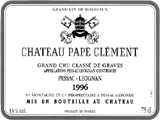
Classification: Classified growth (reds only)
Owner: Bernard Magrez
Address: 216, avenue du Dr Nancel Penard, 33600 Pessac
Mailing address: BP 164, 33600 Pessac
Telephone: 05 57 26 38 38; Telefax: 05 57 26 38 39
E-mail: chateau@pape-clement.com
Website: www.pape-clement.com
Visits: By appointment only
Contact: Eric Larramona
VINEYARDS (RED)
Surface area: 74.1 acres
Grape varietals: 58% Cabernet Sauvignon, 42% Merlot
Average age of vines: 27 years
Density of plantation: 8,000 vines per hectare
Average yields: 39 hectoliters per hectare
Elevage: Three day cold maceration. Fermentation and 21–23 day maceration (26–29 days for Cabernet Sauvignon) in temperature-controlled wooden vats with manual pigeages. Malolactics and 20 months aging in new oak barrels. No fining, filtration depending upon the vintage.
Château Pape Clément: 95,000 bottles
Clémentin du Pape Clément: 45,000 bottles
Plateau of maturity: Within 5–20 years of the vintage
VINEYARDS (WHITE)
Surface area: 6.9 acres
Grape varietals: 45% Sauvignon Blanc, 45% Semillon, 10% Muscadelle
Average age of vines: 20 years
Density of plantation: 8,000 vines per hectare
Average yields: 37 hectoliters per hectare
Elevage: Fermentation and 11 months aging on lees with stirring in barrels with 70% new oak. Fining and filtration.
WHITE WINES PRODUCED
Château Pape Clément: 6,000 bottles
Clémentin du Pape Clément: 4,500 bottles
Plateau of maturity: Within 3–8 years of the vintage
GENERAL APPRECIATION
One of the quintessentially elegant, complex, and most distinctive wines of Bordeaux, Pape Clément has been in top form since the 1986 vintage and especially since its acquisition by Bernard Magrez, who is making every effort to push this estate into Bordeaux’s highest echelon, as vintages since the late 1990s have demonstrated. A must buy for shrewd amateurs!
One of the oldest vineyards and châteaux in Bordeaux, Pape Clément is located in the suburban sprawl of Pessac, several miles from the famed Château Haut-Brion. Historically Pape Clément is among the most significant estates of the Bordeaux region. One of the original owners, Bertrand de Goth, purchased this country estate in 1299 and six years later became Pope Clément V. He was admired by the French for his bold decision to move the papacy to the sun-drenched, hallowed Provençal city of Avignon, where the historical period of the papacy became known as the Babylonian Captivity and the wine produced by Clément at his country estate outside Avignon became known as Châteauneuf du Pape. While Pope Clément V remained in Avignon, he turned over the vineyards of Pape Clément to the church, where they remained undisturbed until divested during the French Revolution.
The vineyard, which was totally destroyed by a ferocious hailstorm in 1937, was resurrected by Paul Montagne, a prominent agricultural engineer who purchased the estate in 1939. It is now controlled by Paul Montagne’s heirs, and managed with great passion and energy by Bernard Magrez.
While no one doubted the quality of Pape Clément’s wines in the early 1970s, 1960s, and 1950s, lack of attention to detail and little investment in winemaking equipment or barrels resulted in a significant deterioration of quality at Pape Clément after 1975. For the next decade the wines produced at the château were often musty, lacked freshness, and, in short, were poorly made. The succession of poor to mediocre results ended in 1985 subsequent to the hiring of the young, enthusiastic Bernard Pujol. Pujol was given total responsibility for resurrecting the quality of Pape Clément, and the result, first evidenced with a profound 1986, has been a succession of wines that now come close to rivaling the great Haut-Brion and La Mission Haut-Brion. Pujol left in the late 1990s, and Bernard Magrez hired the brilliant winemaking consultant Michel Rolland.
Pape Clément, which sits on extremely light, gravelly soil, produces a wine that at its best has a fascinating and compelling bouquet offering up gobs of black fruits intermingled with strong smells of tobacco and minerals. Because of the relatively high percentage of Merlot, it is a wine that can be drunk extremely young yet can age easily for several decades in the best vintages. In the last half of the decade of the 1980s, Pape Clément became one of the stars of Bordeaux, producing profound wines in 2001, 2000, 1998, 1996, 1990, 1988, and 1986.
The new commitment to quality has also been evidenced by an increase in the vineyard area for their rare white wines. Previously, the microscopic production, usually less than 100 cases, was reserved for exclusive use by the château. The property now produces nearly 600 cases. In short, this has become one of the superstar estates of Bordeaux.
IMPORTANT VINTAGES (RED)
ANCIENT VINTAGES (RED)
Pape Clément really did not return to form until the mid-1980s, and vintages from the early 1980s and 1970s are problematic and sometimes disastrous. The 1982 is an appalling wine, and nearly matched in its moldy, mushroom characteristics by the 1981, 1979, 1978, and 1976. The only real strong effort from Pape Clément in the 1970s was the 1975, a very muscular, strong, tannic wine (87 points; last tasted 10/97). In the 1960s, 1961 is the triumph, but it is now in full decline (86? points; last tasted 1/01). This was a wine that could easily score in the low 90s, and I suspect well-kept magnums or larger formats would still be superb.
IMPORTANT VINTAGES (WHITE)
2001 |
A blend of 45% Sauvignon Blanc, 45% Semillon, and 10% Muscadelle, this elegant, medium-bodied white exhibits aromas of orange marmalade intertwined with honeyed citrus, candle wax, and subtle notes of smoky oak. It possesses excellent flavors, good underlying acidity, impressive delineation, and a long, concentrated, fresh, vibrant finish. Drink it over the next 10–12 years. Last tasted, 1/03. |
2000 |
One of the finest efforts of this mediocre vintage for white Graves, this 2000 offers up fruit cocktail–like aromas intermixed with scents of passion fruit, orange peel, lemon zest, and vanilla. Medium bodied, with copious fruit, a fleshy mid-palate, and a dry, crisp, well-balanced finish, it will provide immense enjoyment over the next 7–8 years. Last tasted, 1/03. |
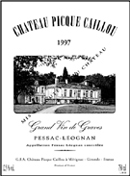
Classification: None
Owner: Isabelle and Paulin Calvet
Address: avenue Pierre Mendès-France, 33700 Mérignac
Telephone: 05 57 47 37 98; Telefax: 05 57 97 99 37
E-mail: chateaupiquecaillou@wanadoo.fr
Visits: By appointment only
Contact: Nicolas Leclair
VINEYARDS (RED)
Surface area: 46.9 acres
Grape varietals: 45% Cabernet Sauvignon, 45% Merlot, 10% Cabernet Franc
Average age of vines: 25 years
Density of plantation: 6,900–10,000 vines per hectare
Average yields: 45 hectoliters per hectare
Elevage: Fermentation and maceration in temperature-controlled (26–30°C) stainless-steel vats. Twelve to fourteen months aging in barrels with 30% new oak. No fining, no filtration.
Château Picque Caillou: 60,000–70,000 bottles
Château Chênevert: 30,000–40,000 bottles
Plateau of maturity: Within 2–12 years of the vintage
VINEYARDS (WHITE)
Surface area: 2.5 acres
Grape varietals: 60% Sauvignon Blanc, 40% Semillon
Average age of vines: 12 years
Density of plantation: 6,900–10,000 vines per hectare
Average yields: 45 hectoliters per hectare
Elevage: Fermentation in vats (20–22°C) and 8 months aging on lees in barrels with stirrings. No fining, no filtration.
WHITE WINES PRODUCED
Château Picque Caillou: 2,000 bottles
Château Chênevert: 2,000 bottles
Plateau of maturity: Within 2–10 years of the vintage
GENERAL APPRECIATION
Under the helmsmanship of Paulin Calvet, the wines of Picque Caillou have progressed considerably. Traditionally made, as opposed to some of their more flamboyant, modern-styled peers, they are, in both red and white, fruity, elegant, rather restrained in a low-key manner—in a word, they deliver the goods.
Picque Caillou is the last surviving vineyard of the commune of Mérignac, which is now better known as the location of Bordeaux’s ever-expanding international airport. The light, gravelly, stony soil, plus the high percentage of Cabernet Sauvignon in the blend, produce an aromatic, fruity wine that can be undeniably seductive when drunk young. The soil is not unlike the terrain of the famous Pessac châteaux of Haut-Brion and Pape Clément, not surprising since they are neighbors. The quality of the winemaking is excellent.
IMPORTANT VINTAGES (RED)
2000 |
This classy, complex Pessac-Léognan is as good as its 1998 counterpart. A sleeper of the vintage, notes of scorched earth, cranberry jam, black cherries, and spice are followed by a sweet, medium-bodied, impeccably balanced, restrained yet flavorful wine. Enjoy it over the next 4–5 years. Last tasted, 1/03. |
1999 |
The elegant, light-bodied 1999 Picque Caillou offers aromas of dark fruits, scorched earth, and a hint of ashtray. It is a superficial, pleasant effort to consume during its first 3–4 years of life. Last tasted, 3/02. |
1998 |
This elegant, medium-bodied 1998 is a classic Graves with its tobacco, smoke, tar, and earthiness. It offers good fruit, medium body, and a straightforward, pleasant style. Drink it over the next 2–3 years. Last tasted, 3/02. |
This property’s track record in the early 1990s and 1980s was disappointing, but that has all changed over recent vintages.
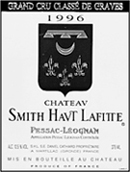
Classification: Classified growth (reds only)
Owner: Daniel and Florence Cathiard
Address: 33650 Martillac
Telephone: 05 57 83 11 22; Telefax: 05 57 83 11 21
E-mail: f.cathiard@smith-haut-lafitte.com
Website: www.smith-haut-lafitte.com
Visits: By appointment, every day of the week, 9 A.M.–12:30 P.M. and 2 P.M.–6:30 P.M. (except on Friday, 5:30 P.M.)
Contact: Virginie Bertot Fletcher
VINEYARDS (RED)
Surface area: 111.2 acres
Grape varietals: 55% Cabernet Sauvignon, 35% Merlot, 10% Cabernet Franc
Average age of vines: 30 years
Density of plantation: 7,500–10,000 vines per hectare
Average yields: 32 hectoliters per hectare
Elevage: Fermentation at 30°C and 24–32 day maceration in temperature-controlled wooden vats of 85-hectoliter capacity on average. Malolactics and 18–20 months aging on lees (with stirring) in barrels with 80% new oak. No fining, no filtration.
RED WINES PRODUCED
Château Smith Haut Lafitte: 100,000 bottles
Les Hauts de Smith: 45,000 bottles
Plateau of maturity: Within 5–25 years of the vintage
VINEYARDS (WHITE)
Surface area: 27.2 acres
Grape varietals: 90% Sauvignon Blanc, 5% Sauvignon Gris, 5% Semillon
Average age of vines: 30 years
Density of plantation: 7,500–10,000 vines per hectare
Average yields: 35 hectoliters per hectare
Elevage: Fermentation at 20°C and 12 months aging on lees with stirring in barrels with 50% new oak. Fining, no filtration.
WHITE WINES PRODUCED
Château Smith Haut Lafitte: 30,000 bottles
Les Hauts de Smith: 21,000 bottles
Plateau of maturity: Within 5–15 years of the vintage
This once mediocre wine has dramatically improved under the dynamic ownership of Florence and Daniel Cathiard. Smith Haut Lafitte is now among the finest Pessac-Léognans.
For decades, while under the ownership of Bordeaux’s Eschenauer family, Smith Haut Lafitte was a perennial underachiever. However, this magnificent estate was sold in 1991 to Florence and Daniel Cathiard. Admittedly they had the misfortune of having to deal with the rain-plagued vintages of 1995, 1994, 1993, 1992, and 1991, but through their extraordinary commitment to quality, a ruthless selection process, and a long-term vision for this estate, they produced better wines in the difficult vintages of the early 1990s than the previous owner was able to do in such exceptional years as 1990 and 1982. Today Smith Haut Lafitte is one of Bordeaux’s shining success stories, reflecting what hard work and conscientious proprietors can achieve in a short period of time.
The style of both the white and red wines combines authoritative richness with considerable elegance, finesse, and complexity. The international marketplace is often fickle, and it seems to me the prices fetched by recent vintages of Smith Haut Lafitte are below what they ultimately will be once the quality of these wines becomes known by the wine world.
IMPORTANT VINTAGES (RED)
2001 |
The 2001 is another beauty from this property. The impressive, perfumed aromatics consisting of black raspberries, spring flowers, currants, graphite, and new oak are followed by an elegantly etched, medium-bodied, moderately weighty Graves with abundant quantities of sweet fruit. Although it does not possess the power and volume of the 2000, it is a complex, harmonious effort with excellent definition as well as delicacy. Proprietor Florence Cathiard believes it to be just as good as the 2000, and she may prove to be right. Certainly it is a wine of exceptional freshness, purity, and complexity. Anticipated maturity: 2006–2015. Last tasted, 1/03. |
2000 |
The finest Smith Haut Lafitte I have ever tasted, the opaque purple–colored 2000 offers scents of tobacco, camphor, graphite, crème de cassis, and licorice. This full-bodied, concentrated effort possesses low acidity, a multilayered texture, and a persistent finish with considerable ripe, well-integrated tannin. It is an impressive tour de force for this estate. Kudos to the Cathiards. Anticipated maturity: 2008–2025. Last tasted, 1/03. |
1999 |
This is a sizable wine for the vintage, although I do not believe it will have the longevity of the 1998 or 2000. A deep ruby/purple color is accompanied by sweet, asphalt-tinged, earthy, cassis fruit with toasty notes in the background. There are loads of fruit and charm as well as a creamy texture revealing hints of tobacco, currants, and wood smoke. Medium bodied and supple textured, it will provide ideal drinking over the next 12 years. Last tasted, 3/02. |
1998 |
A beautiful wine of symmetry, finesse, and elegance, this deep ruby/purple–colored offering reveals classic aromas of black currants, new wood, and scorched earth. This pure, medium-bodied, restrained, measured, graceful 1998 offers impressive overall symmetry and well-integrated tannin. Anticipated maturity: now–2018. Last tasted, 3/02. |
Splendid aromatics of tobacco, ripe black currant fruit, minerals, and toasty oak emerge from this dark ruby–colored effort. Quintessentially elegant, with sweet fruit on the attack, medium body, and no hard edges, this smoothly textured wine can be drunk now as well as over the next 7–8 years. Last tasted, 1/02. |
|
1996 |
The 1996 Smith Haut Lafitte is the quintessentially elegant Bordeaux. With a dark ruby/purple color, it displays a beautiful presentation of blackberry and cassis fruit nicely dosed with subtle new oak. On the attack, the wine is sweet and pure, with striking symmetry, and a compellingly balanced mid-palate and finish. Although not as big as some blockbusters from this vintage, it is extremely complex (both aromatically and flavor-wise), and impressive for its restraint. Anticipated maturity: now–2016. Last tasted, 1/02. |
1995 |
This wine’s deep ruby/purple color is followed by scents of roasted herbs intermixed with sweet black currant fruit, truffles, vanilla, and minerals. Lush, with ripe cassis fruit on the attack, outstanding balance, medium body, and layers of intensity, this is an elegant, graceful, smoothly textured, beautifully made Bordeaux. Anticipated maturity: now–2018. Last tasted, 1/00. |
1994 |
Smith Haut Lafitte has managed to subdue the potential for astringent tannin in this vintage, producing a surprisingly soft, supple, velvety-textured 1994. This wine possesses a healthy purple color, a smoky, spicy, black currant-scented nose, sweet, medium-bodied, well-endowed flavors, a youthfulness and grapiness that does not yet exhibit the complexity of the 1993, and a moderately tannic finish. The 1994 should keep another 10 years. Last tasted, 1/97. |
1993 |
A deep ruby/purple color is impressive for a 1993 Pessac-Léognan. The wine exhibits a textbook Graves nose of smoke, hot rocks, sweet currant and mulberry fruit, and a touch of roasted herbs. Elegant yet flavorful, this medium-bodied, concentrated wine reveals a sweet ripeness and entry on the palate, light tannin, a beautiful dose of toasty new oak, and a suave, savory style. This wine defines what I mean when I say that French wines often possess intensity without significant weight. Drink this lovely offering over the next 6–7 years. Last tasted, 1/97. |
1992 |
The 1992 is unquestionably a successful wine for this vintage. It exhibits elegant, spicy, mineral and black cherry-scented notes in its smoky bouquet, medium body, fine ripeness and extraction, a velvety texture, and light tannin in the finish. Drink it over the next 7–8 years. Last tasted, 11/94. |
ANCIENT VINTAGES (RED)
The wines produced prior to this estate’s acquisition by the Cathiards are largely disappointing. The words “caveat emptor” would certainly be operative should consumers run into any vintages from the 1980s or 1970s.
IMPORTANT VINTAGES (WHITE)
2001 |
A fabulous, complex perfume reveals scents of herbs, licorice, white peaches, honey, and citrus. This medium-bodied, gorgeously proportioned dry white Graves exhibits flavors of figs, lanolin, and white flowers. Beautifully textured, tremendously pure, and authoritatively flavored yet remarkably elegant, it can be drunk now and over the next 12–15 years. Last tasted, 1/03. |
2000 |
A competent effort in a so-so vintage for dry whites from Pessac-Léognan, Smith Haut Lafitte’s 2000 exhibits notions of lemon zest, grapefruit, and minerals in its medium-bodied, earthy personality. Drink it over the next 5–8 years. Last tasted, 1/03. |